A.I. Reveals the Greatest Achievements and Failures of U.S. Presidential Administrations up to September 2021
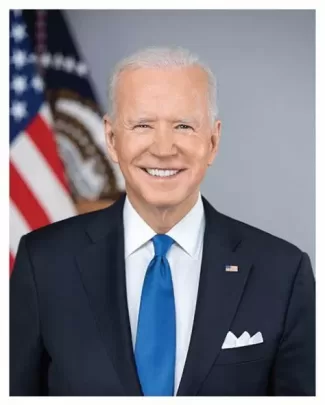
Joe Biden
46. Democratic - Joe Biden / Kamala Harris - January 20, 2021 to present
- COVID-19 Vaccination Campaign: The administration launched an ambitious effort to accelerate COVID-19 vaccinations, aiming for 100 million shots in the first 100 days and ultimately exceeding that target. They worked to increase vaccine availability, distribution, and public awareness.
- American Rescue Plan: The Biden administration successfully passed a $1.9 trillion COVID-19 relief package, providing economic stimulus payments, extended unemployment benefits, aid to state and local governments, funding for vaccine distribution, and support for small businesses.
- Rejoining the Paris Agreement: The administration rejoined the Paris Agreement on climate change, signaling a commitment to global efforts to address climate change and reduce greenhouse gas emissions.
- Infrastructure Plan: The administration proposed a $2.3 trillion infrastructure plan aimed at improving the nation’s transportation, broadband, clean energy, and water systems, with a focus on job creation and climate resilience.
- American Jobs Plan: The American Jobs Plan aims to invest in infrastructure, innovation, and clean energy, with a focus on creating jobs, supporting manufacturing, and advancing green technologies.
- Increased COVID-19 Relief and Economic Support: The administration provided additional relief through initiatives like the Child Tax Credit expansion, rental assistance programs, and increased healthcare subsidies, aiming to provide economic support during the pandemic.
- Diversity and Inclusion: The administration prioritized diversity and inclusion, with a commitment to diverse cabinet appointments, addressing systemic racism, and promoting equality in policies and practices.
- Climate Change Policies: The administration implemented measures to address climate change, including executive actions, setting emissions reduction targets, and promoting clean energy investments.
- Revitalizing International Alliances: The administration worked to rebuild alliances with international partners, aiming to strengthen collective efforts on issues like climate change, global health, and regional stability.
- Infrastructure and Job Creation: The administration sought to create jobs through infrastructure investments, such as the proposed infrastructure plans, with a focus on rebuilding and modernizing the country’s infrastructure.
- Immigration and Border Crisis: The administration faced challenges in managing a surge of migrants at the southern border and addressing immigration policies and border security effectively.
- Gun Control Legislation: Despite calls for stronger gun control measures following multiple mass shootings, the administration faced challenges in advancing significant gun control legislation.
- Voting Rights Protection: The administration faced obstacles in advancing federal voting rights legislation, with some measures facing opposition in Congress and state legislatures.
- Bipartisan Cooperation: The administration faced challenges in achieving broad bipartisan support for key policy initiatives, leading to potential hurdles in passing legislation.
- Foreign Policy Challenges: The administration faced ongoing challenges in managing relationships with countries like China, Russia, and North Korea, as well as navigating complex global issues such as trade disputes and conflicts.
- Criminal Justice Reform: Despite calls for criminal justice reform, progress on enacting comprehensive reforms faced challenges and complexities in Congress.
- Infrastructure Plan Passage: The passage of the administration’s infrastructure plans faced challenges, including negotiations on funding sources, concerns over tax increases, and disagreements on the scope and priorities of the plans.
- Rising Inflation and Economic Concerns: The administration faced economic challenges, including rising inflation rates and concerns over long-term fiscal sustainability related to increased spending and national debt.
- Unity and Polarization: The administration faced difficulties in achieving unity and overcoming political polarization, with significant divisions on key issues among political parties and within the country.
- Pandemic Management: While the administration made progress in vaccine distribution and relief efforts, challenges remained in managing the ongoing COVID-19 pandemic, including evolving variants, vaccine hesitancy, and coordination among states.

Donald Trump
45. Republican - Donald Trump / Mike Pence - January 20, 2017 to January 20,2021
- Tax Cuts and Jobs Act: The administration successfully passed the Tax Cuts and Jobs Act, which aimed to lower corporate and individual tax rates, simplify the tax code, and promote economic growth.
- Criminal Justice Reform: The administration played a role in passing the First Step Act, a bipartisan criminal justice reform bill aimed at reducing recidivism rates, improving prison conditions, and promoting rehabilitation.
- Deregulation: The administration pursued an agenda of deregulation, aiming to reduce government regulations on businesses and industries to stimulate economic growth and innovation.
- Economic Growth and Low Unemployment: The administration’s policies were associated with a period of economic expansion, characterized by low unemployment rates and increased job creation.
- Middle East Peace Agreements: The administration brokered diplomatic agreements between Israel and Arab nations, known as the Abraham Accords, aimed at normalizing relations and promoting stability in the Middle East.
- Criminal Justice and Police Reform: The administration established the Presidential Commission on Law Enforcement and the Administration of Justice, focusing on addressing issues such as excessive use of force and improving community-police relations.
- Veterans Affairs Reform: The administration worked to improve the Veterans Affairs (VA) system, implementing reforms to enhance access to healthcare for veterans and address inefficiencies within the VA.
- Regulatory Reform: The administration implemented policies aimed at reducing regulatory burdens on businesses, streamlining permitting processes, and encouraging economic growth.
- Space Exploration: The administration prioritized space exploration, establishing the Space Force as a separate branch of the military and directing efforts toward returning astronauts to the Moon through the Artemis program.
- Tax Reform for Opportunity Zones: The administration promoted tax incentives and investment opportunities in economically distressed areas through the creation of Opportunity Zones, aiming to stimulate economic development in those communities.
- Response to COVID-19: The administration faced criticism for its handling of the COVID-19 pandemic, including the initial response, testing delays, conflicting messaging, and challenges in vaccine distribution.
- Immigration Policies and Family Separation: The administration faced significant criticism and legal challenges for its immigration policies, including the separation of families at the U.S.-Mexico border and the implementation of the “zero tolerance” policy.
- Racial Unrest and Civil Rights: The administration faced criticism for its response to racial unrest and civil rights issues, including incidents of police violence and concerns over systemic racism.
- Climate Change and Environmental Policies: The administration faced criticism for rolling back environmental regulations and withdrawing from international climate agreements, with concerns over the impact on environmental protection and efforts to address climate change.
- Trade Policies and Tariffs: The administration’s trade policies, including the use of tariffs, faced criticism for potential negative effects on global trade, increased costs for businesses, and strained relationships with trading partners.
- Erosion of Diplomatic Alliances: The administration faced challenges in maintaining strong diplomatic alliances with traditional allies, raising concerns over the strain on international cooperation and partnerships.
- Ethics and Transparency: The administration faced criticism for alleged ethics violations and lack of transparency, including conflicts of interest related to business holdings and controversies surrounding White House personnel.
- Failed Repeal of the Affordable Care Act: Despite campaign promises, the administration’s efforts to repeal and replace the Affordable Care Act (Obamacare) faced significant challenges and ultimately did not succeed.
- Polarization and Divisiveness: The administration was marked by heightened political polarization and divisive rhetoric, which contributed to social divisions and strained public discourse.
- Failure to Condemn White Supremacy: The administration faced criticism for its response to incidents involving white supremacy and its perceived reluctance to consistently and unequivocally condemn white supremacy and extremist groups which led to concerns that the administration failed to provide strong leadership against extremist ideologies.
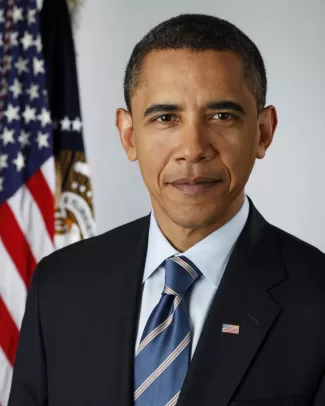
Barrack Obama
44. Democratic - Barack Obama / Joe Biden - January 20, 2009 to January 20, 2017
- Affordable Care Act (ACA): The Obama administration successfully passed the ACA, aiming to expand access to healthcare and reduce the number of uninsured Americans.
- Economic Recovery: The administration implemented measures to address the economic recession inherited from the previous administration, leading to a period of economic growth and job creation.
- Rescue of the Auto Industry: The administration intervened to rescue and restructure the American automobile industry, preventing the collapse of major companies and preserving jobs.
- Marriage Equality: The administration supported the legalization of same-sex marriage and celebrated the landmark Supreme Court ruling in Obergefell v. Hodges, granting marriage equality nationwide.
- Iran Nuclear Deal: The administration negotiated the Joint Comprehensive Plan of Action (JCPOA), an international agreement aimed at preventing Iran from obtaining nuclear weapons.
- Paris Agreement on Climate Change: The administration played a crucial role in the negotiation and signing of the Paris Agreement, a global accord to combat climate change and reduce greenhouse gas emissions.
- Dodd-Frank Wall Street Reform and Consumer Protection Act: The administration signed this legislation into law, aiming to regulate the financial industry, strengthen consumer protections, and prevent future economic crises.
- Education Reform: The administration pursued education reform efforts, such as the Race to the Top initiative, which encouraged innovation and improvement in K-12 education systems.
- Auto Emissions Standards: The administration implemented stricter fuel efficiency standards for automobiles, aiming to reduce greenhouse gas emissions and promote cleaner vehicles.
- Cuba Policy Shift: The administration initiated a historic shift in U.S.-Cuba relations, leading to the restoration of diplomatic ties and easing of travel and trade restrictions.
- Slow Economic Recovery: Despite efforts to stimulate the economy, the pace of the economic recovery was slower than desired, and many Americans still faced financial hardship.
- Partisan Gridlock in Congress: The administration faced significant challenges in passing key legislation due to partisan gridlock and opposition from congressional Republicans.
- Affordable Care Act Implementation Issues: The rollout of the ACA faced technical glitches and challenges, leading to criticism and concerns about the effectiveness and affordability of the healthcare law.
- Immigration Reform Stalemate: Despite efforts to pass comprehensive immigration reform, the administration faced obstacles and failed to achieve significant progress in this area.
- Increased Partisanship and Political Polarization: The administration faced a heightened level of political polarization and partisan divisions, which hindered bipartisan cooperation and policy implementation.
- Escalation of Drone Strikes: The administration faced criticism for the expansion of drone strikes in regions such as Afghanistan, Pakistan, Yemen, and Somalia, raising concerns about civilian casualties and legal implications.
- National Security Challenges: The administration faced ongoing national security challenges, including the rise of ISIS, ongoing conflicts in Afghanistan and Iraq, and evolving cybersecurity threats.
- Limited Progress on Gun Control: Despite several high-profile mass shootings, the administration faced significant challenges in passing comprehensive gun control legislation due to opposition in Congress.
- Rising Income Inequality: Despite efforts to address income inequality, the gap between the wealthiest Americans and the middle class continued to widen during the Obama administration.
- Limited Progress on Criminal Justice Reform: Despite acknowledging the need for criminal justice reform, the administration faced challenges in enacting comprehensive reforms and addressing issues such as mass incarceration and police-community relations.
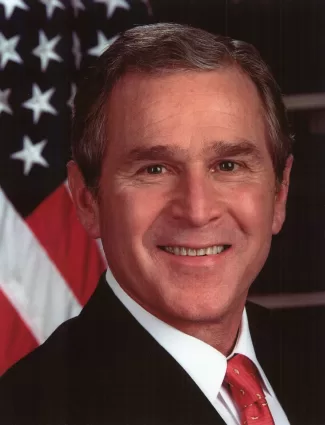
George W. Bush
43. Republican - George W. Bush / Dick Cheney - January 20, 2001 to January 20, 2009
- Response to 9/11: The administration led the response to the September 11, 2001 terrorist attacks, including the establishment of the Department of Homeland Security and the initiation of military operations in Afghanistan to dismantle al-Qaeda.
- Medicare Prescription Drug Coverage: The administration successfully passed the Medicare Prescription Drug, Improvement, and Modernization Act, which added prescription drug coverage to the Medicare program.
- No Child Left Behind Act: The administration signed the No Child Left Behind Act into law, aiming to improve the quality of education by setting standards and accountability measures for schools.
- PEPFAR: The President’s Emergency Plan for AIDS Relief (PEPFAR) was launched under the Bush administration, providing substantial funding to combat HIV/AIDS globally, particularly in hard-hit African countries.
- Tax Cuts: The administration implemented tax cuts, including the Economic Growth and Tax Relief Reconciliation Act and the Jobs and Growth Tax Relief Reconciliation Act, aiming to stimulate economic growth and provide tax relief to individuals and businesses.
- Partial-Birth Abortion Ban Act: The administration supported and signed the Partial-Birth Abortion Ban Act, prohibiting a specific late-term abortion procedure.
- Afghanistan Invasion: The administration launched military operations in Afghanistan to oust the Taliban regime and disrupt al-Qaeda following the September 11 attacks.
- Global War on Terror: The administration led efforts to combat terrorism globally, including the establishment of the Department of Homeland Security and the initiation of military operations in Iraq.
- Immigration Reform Efforts: The administration proposed comprehensive immigration reform that included a pathway to citizenship for certain undocumented immigrants, although the legislation did not pass.
- Humanitarian Aid and Disaster Response: The administration provided significant humanitarian aid and led disaster response efforts, including those following the Indian Ocean tsunami in 2004 and Hurricane Katrina in 2005.
- Iraq War and Weapons of Mass Destruction: The administration faced criticism and controversy over the Iraq War, particularly the failure to find weapons of mass destruction, which were cited as a primary justification for the invasion.
- Response to Hurricane Katrina: The administration faced criticism for its response to Hurricane Katrina in 2005, with allegations of inadequate preparedness and response efforts.
- Financial Crisis of 2008: The administration faced challenges related to the global financial crisis, including the collapse of major financial institutions and the subsequent economic recession.
- Failure to Capture Osama bin Laden: Despite significant efforts, the administration did not capture or eliminate Osama bin Laden, the mastermind behind the 9/11 attacks, during its tenure.
- Guantanamo Bay Detention Center: The administration faced criticism for the indefinite detention of individuals at Guantanamo Bay without trial and concerns over human rights abuses.
- Failure to Enact Social Security Reform: The administration faced challenges in its efforts to reform Social Security, including the introduction of private accounts, which did not gain sufficient support in Congress.
- Lack of International Support for the Iraq War: The administration faced challenges in garnering broad international support for the Iraq War, leading to strained relationships with some traditional allies.
- Erosion of Civil Liberties: The administration faced criticism for its approach to national security and counterterrorism, with concerns over civil liberties violations, such as warrantless wiretapping and enhanced interrogation techniques.
- Rising National Debt: Despite tax cuts and economic growth, the administration faced criticism for its fiscal policies, which contributed to a significant increase in the national debt.
- Poor Post-War Planning in Iraq: The administration faced challenges in post-war planning and stabilization efforts in Iraq, leading to sectarian violence and instability in the region.
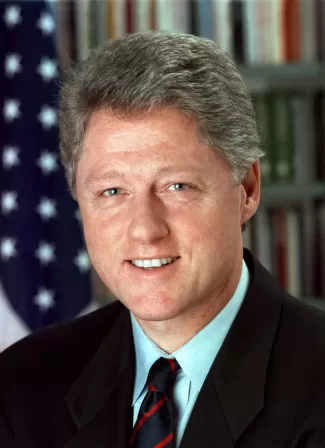
Bill Clinton
42. Democratic - Bill Clinton / Al Gore - January 20, 1993 to January 20, 2001
- Economic Growth and Budget Surpluses: The administration presided over a period of robust economic growth, with low unemployment rates, increased job creation, and budget surpluses by the end of President Clinton’s second term.
- Welfare Reform: The administration successfully worked with Congress to pass the Personal Responsibility and Work Opportunity Reconciliation Act, which aimed to reform the welfare system by promoting work and self-sufficiency.
- North American Free Trade Agreement (NAFTA): The administration negotiated and implemented NAFTA, a trade agreement between the United States, Canada, and Mexico, aimed at reducing barriers to trade and promoting economic cooperation.
- Family and Medical Leave Act (FMLA): The administration signed the FMLA into law, providing eligible employees with job-protected leave for certain family and medical reasons.
- Gun Control Measures: The administration supported and signed the Brady Bill, which mandated background checks for firearm purchases, and the Federal Assault Weapons Ban, which restricted the sale of certain semi-automatic firearms.
- NATO Enlargement: The administration oversaw the expansion of the North Atlantic Treaty Organization (NATO), welcoming new member countries from Eastern Europe and strengthening transatlantic security cooperation.
- Balanced Budget Act: The administration worked with Congress to pass the Balanced Budget Act of 1997, aiming to balance the federal budget and address fiscal concerns.
- Education Reform: The administration prioritized education reform efforts, including the implementation of the Goals 2000 program and the Elementary and Secondary Education Act (ESEA) reauthorization.
- Global Diplomacy: The administration engaged in diplomatic efforts to promote peace and stability, including brokering the Dayton Agreement to end the Bosnian War and facilitating negotiations between Israel and Palestine.
- Expanded Access to Healthcare: The administration advocated for and implemented policies to expand access to healthcare, such as the Children’s Health Insurance Program (CHIP) and the Health Insurance Portability and Accountability Act (HIPAA).
- Impeachment Proceedings: The administration faced impeachment proceedings stemming from the Monica Lewinsky scandal, which created a significant political and legal challenge.
- Failed Healthcare Reform: The administration’s efforts to pass comprehensive healthcare reform, led by the proposed Health Security Act, ultimately failed to gain sufficient support in Congress.
- Controversies Surrounding Whitewater and Travelgate: The administration faced controversies and investigations related to the Whitewater real estate deal and the firing of employees in the White House travel office.
- Ethnic Conflict in Kosovo: The administration faced challenges in responding to the ethnic conflict and humanitarian crisis in Kosovo, ultimately leading to a military intervention.
- Deregulation and Financial Industry Oversight: The administration faced criticism for its role in deregulating the financial industry, which some argue contributed to the conditions that led to the 2008 financial crisis.
- Failure to Enact Comprehensive Immigration Reform: Despite pledges to address immigration reform, the administration faced challenges in passing comprehensive legislation to address the issue.
- Rising Income Inequality: Despite a period of economic growth, income inequality continued to widen during the Clinton administration, raising concerns about wealth disparities.
- Criticism of Military Actions: The administration faced criticism and controversies related to military actions, including the Somalia intervention and the U.S. bombing of the Al-Shifa pharmaceutical factory in Sudan.
- Troubles in Somalia and Rwanda: The administration faced challenges and criticism for the handling of the conflicts in Somalia and the failure to intervene effectively in the Rwandan genocide.
- Failure to Address Climate Change: The administration faced criticism for not taking more significant action to address climate change during its tenure.
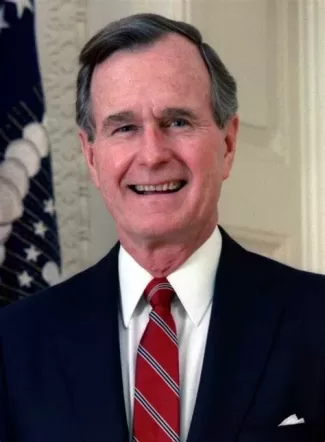
George H. W. Bush
41. Republican - George H. W. Bush / Dan Quayle - January 20, 1989 to January 20, 1993
- End of the Cold War: The administration played a significant role in managing the peaceful transition of power in the Soviet Union and the end of the Cold War, including fostering diplomacy and arms reduction treaties.
- Gulf War: The administration successfully led a coalition of international forces to liberate Kuwait from Iraqi invasion in the Gulf War, demonstrating strong international leadership.
- Americans with Disabilities Act (ADA): The administration supported and signed the ADA into law, aiming to protect the rights of individuals with disabilities and ensure equal opportunities in employment, public accommodations, and transportation.
- Clean Air Act Amendments: The administration worked with Congress to pass amendments to the Clean Air Act, aimed at reducing air pollution and promoting environmental protection.
- Strategic Arms Reduction Treaty (START): The administration negotiated and signed the START treaty with the Soviet Union, reducing the number of strategic nuclear weapons.
- Americans with Disabilities Act (ADA): The administration supported and signed the ADA into law, aiming to protect the rights of individuals with disabilities and ensure equal opportunities in employment, public accommodations, and transportation.
- Skillful Diplomacy in German Reunification: The administration played a key role in supporting and managing the peaceful reunification of East and West Germany, maintaining stability in Europe.
- Strong Relations with China: The administration developed strong diplomatic and economic ties with China, paving the way for improved U.S.-China relations.
- Expansion of Global Free Trade: The administration championed free trade, including the negotiation and signing of the North American Free Trade Agreement (NAFTA) and pursuing negotiations for the Uruguay Round of the General Agreement on Tariffs and Trade (GATT).
- Leadership During National Crises: The administration demonstrated strong leadership during domestic crises, such as the response to Hurricane Andrew and the riots in Los Angeles following the Rodney King verdict.
- Economic Downturn and Recession: The administration faced economic challenges, including a recession in the early 1990s, which affected employment and raised concerns about the state of the economy.
- Broken Promise on Taxes: The administration faced criticism for breaking the “Read my lips: no new taxes” pledge, which contributed to a perception of broken trust with the public.
- Incomplete Agenda on Domestic Policy: The administration faced challenges in implementing a comprehensive domestic policy agenda, including healthcare reform and education reform.
- Insufficient Action on Climate Change: The administration faced criticism for not taking more aggressive action to address climate change and reduce greenhouse gas emissions.
- Failed Re-election Campaign: The administration was not successful in its bid for re-election, facing challenges in conveying a compelling message to the American people.
- Limited Progress on Gun Control: Despite some efforts to address gun control issues, the administration faced challenges in enacting comprehensive gun control legislation.
- Controversy Surrounding Iran-Contra Affair: Though the Iran-Contra affair took place during the Reagan administration, it continued to cast a shadow on the George H. W. Bush administration due to his role as Vice President at the time.
- Response to the Los Angeles Riots: The administration faced criticism for the handling of the response to the riots in Los Angeles following the Rodney King verdict, with some perceiving a delayed and insufficient federal response.
- Slow Response to the HIV/AIDS Crisis: The administration faced criticism for what some perceived as a slow response to the HIV/AIDS crisis, with calls for more robust federal action and funding.
- Tension with Congress: The administration faced challenges in working with Congress and experienced strained relationships, which impacted its ability to advance certain policy initiatives.

Ronald Reagan
40. Republican - Ronald Reagan / George H. W. Bush - January 20, 1981 to January 20, 1989
- Economic Recovery: Reaganomics implemented policies that stimulated economic growth, reduced inflation, and led to a sustained period of economic expansion.
- Cold War Victory: Reagan’s strong anti-communist stance and strategic approach contributed to the end of the Cold War and the collapse of the Soviet Union.
- Tax Reform: The Tax Reform Act of 1986 simplified the tax code, lowered tax rates, and closed loopholes, promoting economic growth and fairness.
- Deregulation: The Reagan administration pursued deregulation across various industries, fostering innovation and competition.
- Arms Control Agreements: Reagan’s negotiations with the Soviet Union led to significant arms control agreements, such as the INF Treaty, reducing nuclear tensions.
- Strengthened Military: Increased defense spending and military modernization programs improved the U.S. military’s capabilities.
- Welfare Reform: The Reagan administration implemented reforms aimed at reducing dependency on welfare programs and promoting self-sufficiency.
- Tax Cuts: Reagan’s tax cuts aimed to stimulate economic growth and incentivize investment.
- Space Exploration: The Reagan administration emphasized space exploration, leading to the establishment of the Space Shuttle program and the beginning of the International Space Station.
- Improved U.S. Relations with China: Reagan’s efforts to normalize relations with China resulted in expanded trade and cooperation between the two nations.
- Iran-Contra Affair: The illegal sale of arms to Iran and diversion of funds to Contras in Nicaragua led to a major scandal and damaged the administration’s reputation.
- Budget Deficits and National Debt: Despite the goal of reducing government spending, the Reagan administration faced substantial budget deficits and contributed to a significant increase in the national debt.
- Inequality and Poverty: Critics argued that Reagan’s policies exacerbated income inequality and poverty rates.
- Environmental Policies: The Reagan administration faced criticism for relaxed environmental regulations and policies favoring industry interests over environmental conservation.
- HIV/AIDS Crisis: Critics argued that the Reagan administration initially did not respond adequately to the HIV/AIDS crisis, leading to a delayed and insufficient federal response.
- Homelessness: The administration faced challenges in addressing the rise in homelessness, and critics argued that Reagan’s policies contributed to the problem.
- Native American Policy: The administration faced criticism for its handling of Native American issues, particularly regarding land rights and sovereignty.
- Social Issues: Critics argued that Reagan’s administration did not adequately address civil rights issues and women’s rights.
- Education Reform: While the administration sought education reform, critics argued that progress was limited, and disparities in education persisted.
- Labor Unrest: Reagan’s policies and handling of labor issues led to confrontations with labor unions and accusations of anti-labor policies.
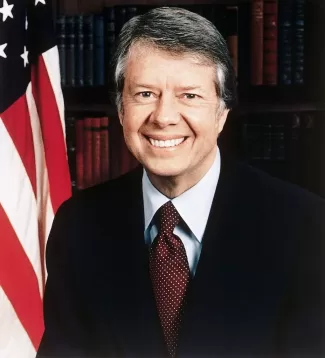
Jimmy Carter
39. Democratic - Jimmy Carter / Walter Mondale - January 20, 1977 to January 20, 1981
- Camp David Accords: President Carter facilitated the Camp David Accords, a historic peace agreement between Israel and Egypt, which helped to stabilize the region and laid the foundation for subsequent negotiations.
- Panama Canal Treaties: The administration negotiated and successfully ratified the Panama Canal Treaties, transferring control of the canal to Panama and improving relations with Latin American countries.
- Human Rights Advocacy: The administration prioritized human rights, promoting democracy and freedom around the world, and placing a greater emphasis on human rights in U.S. foreign policy.
- Energy Policy and Conservation: The administration implemented policies to reduce dependence on foreign oil, encourage energy conservation, and promote alternative energy sources.
- Department of Energy Creation: The administration established the Department of Energy to consolidate energy-related programs and coordinate national energy policies.
- Environmental Protection: The administration took steps to strengthen environmental protection efforts, including the creation of the Superfund program to clean up hazardous waste sites.
- Deregulation of Industries: The administration pursued deregulation in various industries, including transportation and telecommunications, with the aim of promoting competition and consumer choice.
- Nuclear Non-Proliferation: The administration worked to strengthen international non-proliferation efforts, signing the Strategic Arms Limitation Treaty (SALT II) with the Soviet Union.
- Peaceful Transition of the Panama Canal: The administration oversaw a peaceful transition of the Panama Canal to Panamanian control, avoiding potential conflicts and maintaining stability in the region.
- Humanitarian Efforts: The administration prioritized humanitarian aid and disaster relief, including the establishment of the Federal Emergency Management Agency (FEMA) to respond to natural disasters.
- Iranian Hostage Crisis: The administration faced a protracted hostage crisis in Iran, with American diplomats held captive for 444 days, which damaged the administration’s reputation and undermined public confidence.
- Economic Stagnation and Inflation: The administration grappled with an economic downturn, high inflation rates, and a stagnant economy, leading to significant economic challenges and public dissatisfaction.
- Energy Crisis and Oil Shortages: The administration faced challenges in addressing the energy crisis, marked by high oil prices and shortages, which had adverse effects on the economy and everyday life.
- Stalled Efforts at Middle East Peace: Despite the Camp David Accords, the administration was unable to achieve significant progress in resolving the broader Israeli-Palestinian conflict.
- Soviet Invasion of Afghanistan: The administration faced the Soviet Union’s invasion of Afghanistan, and its response, including the boycott of the 1980 Summer Olympics, had limited impact on the conflict.
- Strained Relations with Congress: The administration encountered difficulties in working with Congress, facing challenges in advancing its policy agenda and experiencing strained relationships.
- Inflation and Mismanagement: The administration faced criticism for its handling of economic policies, with inflation rates reaching double digits and perceptions of mismanagement of the economy.
- Decline in U.S. Influence Abroad: The administration faced challenges in maintaining U.S. influence on the global stage, with some perceiving a decline in America’s standing and influence during this period.
- Oil Price Volatility: The administration grappled with the volatility of oil prices, which had significant implications for the U.S. economy and created uncertainty.
- Unemployment and Job Losses: The administration struggled with high unemployment rates and job losses, particularly in industries affected by economic challenges and changes in global trade dynamics.
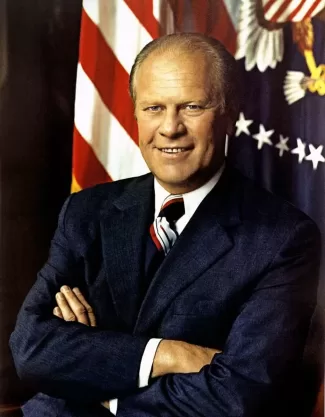
Gerald Ford
38. Republican - Gerald Ford / Nelson Rockefeller (vacant until December 19, 1974) - August 9, 1974 to January 20, 1977
- Pardoning of Richard Nixon: President Ford’s decision to pardon his predecessor, Richard Nixon, aimed at healing the nation and moving forward from the Watergate scandal.
- Helsinki Accords: The administration played a significant role in negotiating and signing the Helsinki Accords, which sought to improve relations between Western and Eastern Europe and promote human rights.
- Vietnam War Withdrawal: The administration oversaw the final stages of the U.S. military withdrawal from Vietnam, effectively ending America’s involvement in the Vietnam War.
- Rebuilding Trust in Government: President Ford aimed to restore public confidence in government institutions, following the turmoil of the Watergate scandal, by emphasizing transparency and integrity.
- Economic Stabilization Efforts: The administration implemented measures to combat inflation and stabilize the economy, including the Whip Inflation Now (WIN) campaign and the Economic Stabilization Act.
- Environmental Protection: The administration signed the Toxic Substances Control Act, aiming to regulate and control toxic chemicals to protect public health and the environment.
- Improving U.S.-China Relations: President Ford made efforts to normalize relations with China, including his historic visit to Beijing, which helped pave the way for future diplomatic and economic cooperation.
- East Timor Humanitarian Aid: The administration provided humanitarian assistance to East Timor following its independence struggle, offering support to the newly independent nation.
- Evacuation of Saigon: The administration successfully executed the evacuation of American citizens and South Vietnamese allies during the fall of Saigon, mitigating potential humanitarian crises.
- Energy Policy Initiatives: The administration focused on energy conservation and reducing dependence on foreign oil, promoting policies such as the Energy Policy and Conservation Act.
- Economic Recession: The administration faced challenges in addressing a severe economic recession marked by high inflation rates, unemployment, and slow economic growth.
- Unsuccessful Re-election Campaign: President Ford was not successful in his bid for re-election, facing challenges in conveying a compelling message and competing against a dynamic political climate.
- Limited Legislative Success: The administration encountered difficulties in advancing its legislative agenda due to a divided Congress and competing policy priorities.
- Controversial Pardon of Richard Nixon: While the pardon aimed at promoting national healing, it also drew significant criticism from those who believed it undermined accountability and the rule of law.
- Lingering Fallout from Watergate: The administration had to grapple with the ongoing fallout and public distrust resulting from the Watergate scandal and its impact on the presidency.
- Energy Crisis and Oil Shortages: The administration faced challenges related to energy crises, including oil shortages and skyrocketing oil prices, which had adverse effects on the economy and everyday life.
- Limited Progress in Middle East Peace: The administration faced challenges in achieving significant progress in resolving the Israeli-Palestinian conflict and stabilizing the region.
- Public Confidence and Perception of Weak Leadership: President Ford faced public perceptions of weak leadership and indecisiveness, which affected his ability to rally support and address pressing issues effectively.
- Inflation and Rising Cost of Living: The administration struggled to combat high inflation rates and rising costs of living, which eroded purchasing power and impacted households across the country.
- Strained Relations with Congress: The administration faced challenges in working with Congress, which limited its ability to pass major legislation and implement its policy agenda.
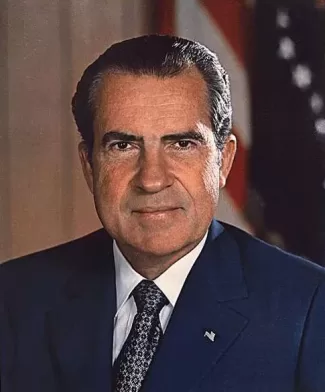
Richard M. Nixon
37. Republican - Richard Nixon / Spiro Agnew (vacant October 10 - December 19, 1973, then Gerald Ford) - January 20, 1969 - August 9, 1974
- Opening Relations with China: President Nixon’s historic visit to China and subsequent normalization of diplomatic relations helped to thaw the Cold War tensions and pave the way for future cooperation.
- Détente with the Soviet Union: The administration pursued a policy of détente with the Soviet Union, leading to important arms control agreements, such as the Strategic Arms Limitation Talks (SALT).
- Environmental Protection: The administration established the Environmental Protection Agency (EPA) and signed into law landmark environmental legislation, including the Clean Air Act and the Clean Water Act.
- Apollo Moon Landing: The administration witnessed the successful Apollo 11 mission, which landed humans on the moon for the first time, showcasing American technological prowess and space exploration capabilities.
- Arms Control Agreements: The Nixon administration signed several arms control agreements, including the Anti-Ballistic Missile Treaty and the Biological Weapons Convention, aimed at reducing the threat of nuclear war and the spread of weapons.
- Desegregation and Civil Rights: The administration implemented affirmative action policies, expanded desegregation efforts, and supported the extension of the Voting Rights Act of 1965.
- Creation of the Occupational Safety and Health Administration (OSHA): The administration established OSHA to enforce workplace safety regulations and protect workers’ health and safety.
- War on Cancer: The administration declared a “War on Cancer” and signed the National Cancer Act, leading to increased funding for cancer research and the establishment of the National Cancer Institute.
- Revenue Sharing with States: The administration implemented revenue-sharing programs to provide funding to state and local governments, granting them more control over the allocation of federal resources.
- Arms Control with Multiple Nations: The administration pursued arms control agreements with multiple nations, including the Treaty on the Non-Proliferation of Nuclear Weapons and the Biological Weapons Convention.
- Watergate Scandal: The Watergate scandal, involving illegal activities and the subsequent cover-up by members of the administration, led to President Nixon’s resignation and a profound loss of public trust in government.
- Vietnam War and Anti-War Protests: The administration faced challenges in managing the ongoing Vietnam War and significant public opposition to the conflict, which fueled anti-war protests and social unrest.
- Cambodian Campaign and Incursion: The administration’s secret bombing campaign and military incursion into Cambodia faced criticism for expanding the war and escalating violence in Southeast Asia.
- Economic Stagflation: The administration grappled with economic challenges, including a combination of high inflation and stagnant economic growth, known as stagflation.
- Pentagon Papers Leak: The leak of the classified Pentagon Papers, which revealed the history of U.S. involvement in Vietnam, exposed internal government contradictions and eroded public trust.
- Strained Civil Rights Relations: The administration faced criticism for its approach to civil rights issues, with some perceiving a lack of progress and insufficient action to address systemic inequalities.
- Strained International Relations: The administration faced challenges in international relations, including strained relationships with traditional allies and geopolitical tensions.
- Implementation of the Southern Strategy: The administration’s adoption of the Southern Strategy, which sought to appeal to white southern voters through racially coded messaging, faced criticism for exacerbating divisions and promoting racial polarization.
- Erosion of Executive Power: The Watergate scandal and subsequent investigations led to increased scrutiny over executive power, highlighting concerns about abuse of authority and violation of constitutional principles.
- Failed War on Drugs: The administration’s approach to the war on drugs faced criticism for its heavy emphasis on law enforcement and punitive measures rather than addressing underlying social issues.
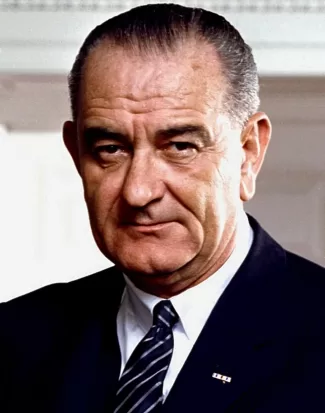
Lyndon B. Johnson
36. Democratic - Lyndon B. Johnson - November 22, 1963 to January 20, 1969 / Hubert Humphrey - vacant through January 20, 1965 to January 20, 1969
- Civil Rights Act of 1964: The administration played a pivotal role in the passage of the landmark Civil Rights Act, which outlawed discrimination based on race, color, religion, sex, or national origin.
- Voting Rights Act of 1965: The administration championed the Voting Rights Act, which aimed to eliminate racial barriers to voting, including literacy tests and poll taxes.
- War on Poverty and Great Society Programs: President Johnson launched an ambitious agenda known as the Great Society, which included programs like Medicare, Medicaid, Head Start, and the Economic Opportunity Act, aimed at reducing poverty and improving social welfare.
- Medicare and Medicaid: The administration successfully implemented Medicare, providing healthcare coverage for elderly Americans, and Medicaid, offering healthcare assistance to low-income individuals and families.
- Immigration and Nationality Act of 1965: The administration signed into law the Immigration and Nationality Act, which abolished discriminatory immigration quotas and prioritized family reunification.
- Space Exploration: The administration advanced the United States’ space exploration efforts, culminating in the successful Apollo program and the moon landing in 1969.
- Elementary and Secondary Education Act: The administration pushed for and signed the Elementary and Secondary Education Act, providing federal funding to improve education in schools with high poverty rates.
- National Endowment for the Arts and Humanities: President Johnson established the National Endowment for the Arts and the National Endowment for the Humanities, supporting and promoting arts and culture in the United States.
- Clean Air Act of 1963: The administration supported and signed the Clean Air Act, aiming to combat air pollution and improve environmental quality.
- Arms Control and Non-Proliferation Efforts: The administration pursued nuclear arms control and non-proliferation agreements, including the signing of the Nuclear Non-Proliferation Treaty.
- Vietnam War: The administration’s handling of the Vietnam War faced criticism for escalating U.S. involvement and the heavy toll it took on American soldiers and Vietnamese civilians.
- Growing Anti-War Movement: The Vietnam War generated widespread opposition, leading to protests and social unrest that challenged the administration’s policies and eroded public support.
- Social Turmoil and Riots: The administration faced civil unrest, including race riots in cities like Detroit and Newark, highlighting underlying social tensions and inequality.
- Lack of Congressional Support: Despite many significant achievements, the administration faced challenges in getting key legislation passed due to a divided Congress and resistance from conservative lawmakers.
- Inflation and Economic Challenges: The administration struggled to control inflation, which eroded purchasing power and posed economic challenges during the period.
- Failure to Implement Comprehensive Gun Control: Despite public concern about rising gun violence, the administration faced challenges in implementing comprehensive gun control legislation.
- Credibility Gap: The administration’s credibility suffered due to discrepancies between official statements and the reality of the Vietnam War, leading to a growing “credibility gap” and public mistrust.
- Urban Decay and Poverty: Despite efforts to address poverty through the War on Poverty, many urban areas faced persistent poverty and deteriorating conditions, with limited progress in solving structural issues.
- Erosion of Public Support and Divisiveness: The administration’s policies and the Vietnam War led to a deep division in public opinion, eroding support and exacerbating social and political divisions.
- Assassinations and Civil Unrest: The nation experienced a series of assassinations, including those of President John F. Kennedy, Martin Luther King Jr., and Robert F. Kennedy, leading to increased civil unrest and a sense of national tragedy.
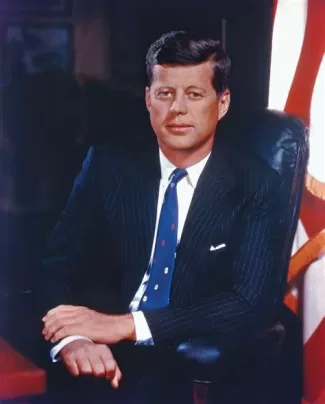
John F. Kennedy
35. Democratic - John F. Kennedy / Lyndon B. Johnson - January 20, 1961 to November 22. 1963
- Cuban Missile Crisis: President Kennedy’s handling of the Cuban Missile Crisis, which successfully resolved the standoff between the United States and the Soviet Union and averted a potential nuclear conflict.
- Space Exploration: The administration’s commitment to space exploration led to significant achievements, including the establishment of NASA and the iconic Apollo moon landing.
- Civil Rights Advocacy: President Kennedy expressed strong support for civil rights, delivering a historic speech on civil rights and taking steps to desegregate public facilities.
- Nuclear Test Ban Treaty: The administration negotiated and signed the Limited Test Ban Treaty, which banned nuclear weapons testing in the atmosphere, underwater, and outer space.
- Alliance for Progress: President Kennedy launched the Alliance for Progress, a program aimed at promoting economic development and social progress in Latin American countries.
- Peace Corps: The administration established the Peace Corps, a volunteer program that promotes international peace and understanding through grassroots development initiatives.
- Equal Pay Act of 1963: President Kennedy signed the Equal Pay Act into law, which aimed to reduce gender-based wage discrimination.
- Flexible Response Doctrine: The administration developed the “flexible response” doctrine, which emphasized a range of military options to address international conflicts and challenges.
- New Frontier Agenda: President Kennedy’s New Frontier agenda included proposals for economic growth, education reform, and healthcare expansion, inspiring public engagement and discussions on key issues.
- Nuclear Arms Control: The administration made progress in nuclear arms control through initiatives such as the Partial Nuclear Test Ban Treaty and the pursuit of a comprehensive nuclear test ban.
- Bay of Pigs Invasion: The administration’s failed attempt to overthrow the Cuban government through the Bay of Pigs invasion, which resulted in a significant embarrassment for the United States.
- Assassination: The tragic assassination of President Kennedy in 1963, cutting short his presidency and leaving many initiatives unfinished.
- Escalation of Vietnam War: While President Kennedy initially increased U.S. involvement in Vietnam, the administration faced challenges in effectively managing and ultimately resolving the conflict.
- Limited Progress on Civil Rights: Despite expressing support for civil rights, the administration faced challenges in achieving significant legislative progress on civil rights issues during Kennedy’s tenure.
- Cold War Tensions: The Kennedy administration had to navigate complex Cold War dynamics and tensions, particularly with the Soviet Union and the Berlin Wall crisis.
- Steel Crisis: The administration faced criticism for its handling of the steel industry crisis, with Kennedy initially supporting a price increase and later clashing with steel executives.
- Space Race and Education Gap: The United States lagged behind the Soviet Union in the space race, highlighting concerns about the education system and technological competitiveness.
- Nuclear Arms Race: The administration faced challenges in managing the nuclear arms race and curbing the proliferation of nuclear weapons worldwide.
- Unresolved Economic Challenges: The administration struggled to address economic issues, including unemployment, inflation, and economic inequality, which persisted during Kennedy’s presidency.
- Organized Crime and Corruption: The Kennedy administration faced criticism for its perceived inability to effectively combat organized crime and corruption, particularly in relation to the Teamsters Union and its connections to the administration.
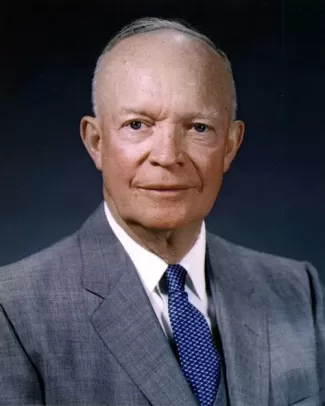
Dwight D. Eisenhower
34. Republican - Dwight D. Eisenhower / Richard Nixon - January 20, 1953 to November 22, 1961
- Interstate Highway System: The administration successfully championed the construction of the Interstate Highway System, a vast network of highways that improved transportation and facilitated economic growth.
- Ending the Korean War: President Eisenhower’s administration negotiated the armistice that ended the Korean War, bringing stability to the region and averting further conflict.
- Brown v. Board of Education: The administration supported the landmark Supreme Court decision in Brown v. Board of Education, which declared racial segregation in public schools unconstitutional.
- Space Exploration: The administration established NASA and initiated significant advancements in space exploration, including launching the first U.S. satellite (Explorer 1) and creating the National Aeronautics and Space Act.
- Civil Rights Initiatives: President Eisenhower signed the Civil Rights Acts of 1957 and 1960, aimed at protecting voting rights and combating racial discrimination.
- Stabilization of the Economy: The administration maintained economic stability during a period of post-war transition and implemented policies that promoted fiscal responsibility and balanced budgets.
- Infrastructure Development: The administration invested in infrastructure projects, including the expansion of hydroelectric power and the construction of the St. Lawrence Seaway.
- Nuclear Arms Control: President Eisenhower pursued nuclear arms control through initiatives such as the Atoms for Peace program, the creation of the International Atomic Energy Agency, and the signing of the Partial Test Ban Treaty.
- Agricultural Reforms: The administration implemented agricultural policies to modernize farming practices, improve efficiency, and support rural development.
- New Look Defense Policy: The administration adopted the “New Look” defense policy, which emphasized the development of nuclear weapons and deterrence capabilities to reduce reliance on conventional forces.
- Civil Rights Progress: Despite supporting civil rights legislation, the administration faced criticism for its perceived lack of urgency in addressing systemic racism and implementing comprehensive civil rights reforms.
- McCarthyism and Red Scare: The Eisenhower administration struggled to contain the influence of McCarthyism and the Red Scare, which led to the persecution of suspected communists and stifled civil liberties.
- Military-Industrial Complex: President Eisenhower, in his farewell address, warned against the influence of the military-industrial complex, which critics argue grew during his presidency.
- Suez Crisis: The administration faced challenges in managing the Suez Crisis, a conflict involving Egypt, Israel, and other Middle Eastern countries, which had implications for U.S. foreign policy in the region.
- Little Rock Crisis: The administration faced criticism for its initially cautious response to the desegregation crisis in Little Rock, Arkansas, before ultimately deploying federal troops to enforce integration.
- Limited Progress on Desegregation: Despite supporting desegregation in public schools, the administration faced challenges in implementing and enforcing meaningful desegregation measures nationwide.
- Cold War Tensions: The administration had to navigate complex Cold War dynamics, including tensions with the Soviet Union and concerns about the spread of communism in various regions.
- Failure to Address McCarthyism: While President Eisenhower publicly criticized Joseph McCarthy’s tactics, he faced criticism for not taking stronger action to challenge McCarthyism and its damaging effects on civil liberties.
- Environmental Conservation: The administration faced criticism for its limited focus on environmental conservation and natural resource management, with concerns raised about pollution and resource depletion.
- Limited Progress on Social Welfare: The administration faced criticism for its perceived lack of progress in addressing poverty and social welfare issues, with some arguing for more comprehensive reforms.
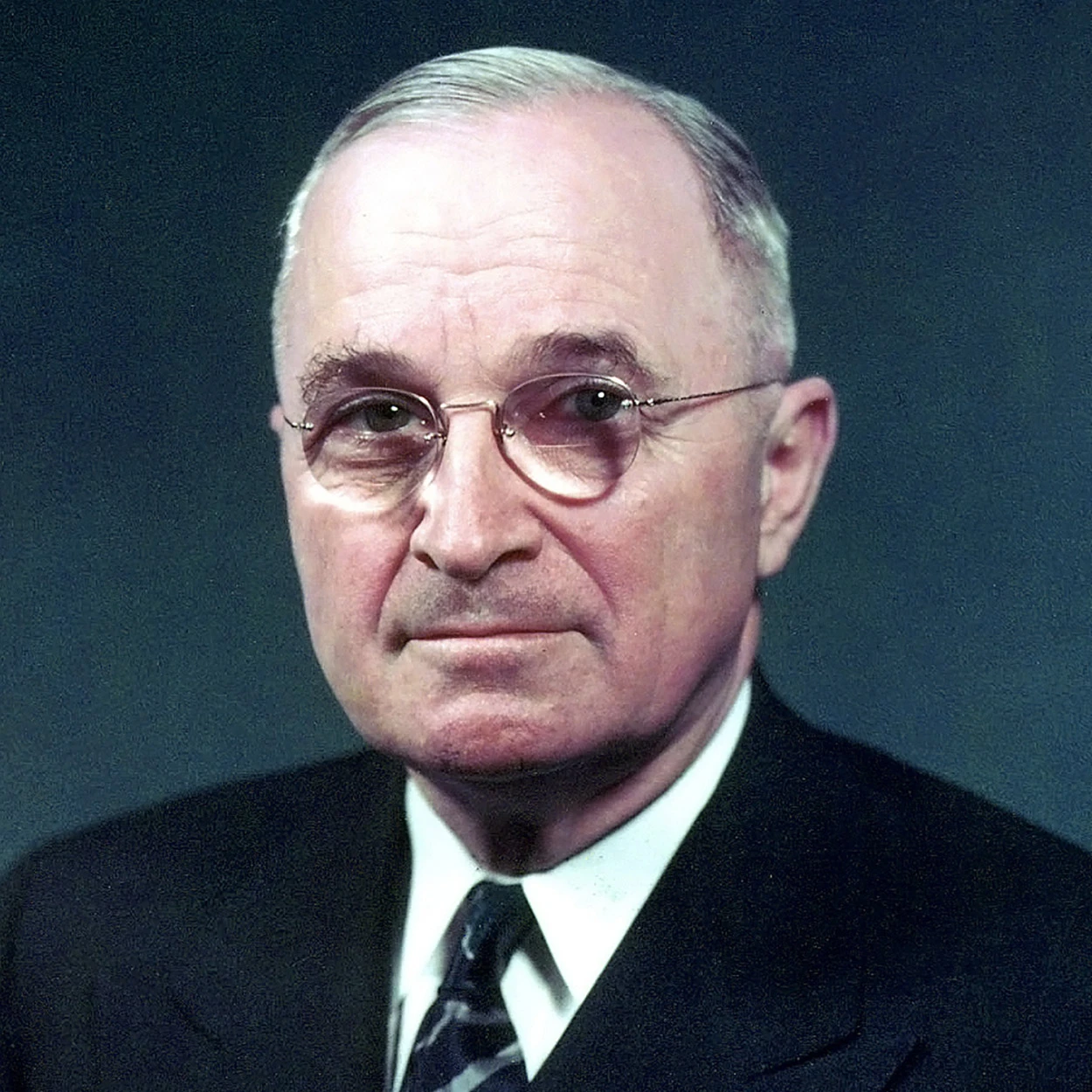
Harry S. Truman
33. Democratic - Harry S. Truman - April 12, 1945 - January 20, 1953 / Alben W. Barkley - Vacant through January 20, 1949 to January 20, 1953
- Truman Doctrine: The administration established the Truman Doctrine, which outlined the United States’ commitment to supporting countries resisting communism, marking the beginning of the Cold War containment policy.
- Marshall Plan: The administration implemented the Marshall Plan, a significant economic aid program that provided financial assistance to help rebuild war-torn Europe and stabilize the region after World War II.
- Formation of the United Nations: The Truman administration played a key role in the establishment of the United Nations, a global organization aimed at promoting international cooperation and peace.
- Desegregation of the Armed Forces: President Truman issued an executive order in 1948 that desegregated the United States Armed Forces, advancing civil rights and challenging racial discrimination.
- Berlin Airlift: The administration successfully organized the Berlin Airlift in response to the Soviet blockade of West Berlin, ensuring the provision of essential supplies to the city and demonstrating U.S. resolve during the early Cold War period.
- Recognition of Israel: President Truman officially recognized the state of Israel in 1948, marking a significant moment in U.S. foreign policy and the Middle East.
- National Security Act of 1947: The administration signed the National Security Act, which established the Department of Defense, the Central Intelligence Agency (CIA), and the National Security Council (NSC), shaping the nation’s security infrastructure.
- Truman’s Fair Deal: President Truman proposed the Fair Deal, an ambitious domestic agenda that aimed to expand social welfare programs, improve civil rights, and promote economic growth and opportunity.
- Korean War Response: The administration responded to North Korea’s invasion of South Korea by mobilizing international support, leading a United Nations force, and defending South Korea against aggression.
- Atomic Energy Act of 1946: The administration signed the Atomic Energy Act, which established civilian control over atomic energy and promoted international cooperation in the peaceful use of nuclear energy.
- Korean War Stalemate: The Korean War resulted in a prolonged stalemate and an unresolved conflict, with no clear victory achieved during Truman’s presidency.
- McCarthyism and Red Scare: The administration faced challenges in addressing the rise of McCarthyism and the Red Scare, which led to the persecution of suspected communists and contributed to an atmosphere of fear and suspicion.
- Chinese Communist Revolution: The Truman administration faced criticism for not effectively anticipating or responding to the Chinese Communist Revolution and the subsequent rise of Mao Zedong’s regime.
- Challenges in Civil Rights: While the administration took steps to address civil rights, some critics argue that more could have been done to tackle systemic racism and inequality.
- Strikes and Labor Disputes: The administration encountered significant labor strikes and disputes during Truman’s tenure, including the Steel Strike of 1952, which strained relations with labor unions.
- Dismissal of General MacArthur: President Truman’s decision to dismiss General Douglas MacArthur during the Korean War generated controversy and public debate.
- Post-War Economic Challenges: The administration faced challenges in transitioning from a wartime to a peacetime economy, including inflation, labor market adjustments, and readjustment issues for returning veterans.
- Early Cold War Tensions: The Truman administration had to navigate the challenges of the early Cold War period, including tense relations with the Soviet Union, the division of Europe, and the arms race.
- Limited Progress on Civil Liberties: Despite efforts to address civil liberties concerns, some critics argue that the Truman administration fell short in protecting individual rights during the Red Scare and McCarthy era.
- Lack of Support for Progressive Reforms: President Truman faced challenges in gaining support for his progressive domestic policy agenda, including the Fair Deal, with many of his proposals facing opposition in Congress.

Franklin D. Roosevelt
32. Democratic - Franklin D. Roosevelt - March 4, 1933 to April 12, 1945 / John Nance Garner - March 4, 1933 to January 20, 1941, Henry A. Wallace - January 20, 1941 to January 20, 1945, Harry S. Truman - April 12, 1945 to January 20, 1953
- New Deal Programs: The administration implemented a wide range of New Deal programs aimed at stabilizing the economy, providing relief to the unemployed, and reforming the financial system during the Great Depression.
- Social Security Act: President Roosevelt signed the Social Security Act into law, establishing a system of social insurance to provide financial support for the elderly, unemployed, and disabled.
- Leadership During World War II: President Roosevelt led the United States through World War II, mobilizing the nation’s resources, implementing war production efforts, and forming alliances with other Allied powers.
- Lend-Lease Act: The administration successfully advocated for and implemented the Lend-Lease Act, which provided military aid and supplies to Allied countries during World War II.
- Good Neighbor Policy: The administration pursued a Good Neighbor Policy towards Latin American countries, emphasizing non-intervention and improved relations with neighboring nations.
- Rural Electrification: The administration launched the Rural Electrification Administration (REA) to bring electricity to rural areas, spurring economic development and improving quality of life.
- Banking Reforms: President Roosevelt implemented significant banking reforms, including the Glass-Steagall Act, to regulate the banking industry and prevent future financial crises.
- Conservation and Environmental Policies: The administration prioritized conservation efforts, establishing national parks, forests, and wildlife refuges, and implementing programs to combat soil erosion and promote sustainable farming practices.
- Fair Labor Standards Act: President Roosevelt signed the Fair Labor Standards Act, which established a minimum wage, regulated working hours, and prohibited child labor.
- Creation of the United Nations: The Roosevelt administration played a key role in the establishment of the United Nations, a global organization aimed at promoting international cooperation and peace.
- Japanese Internment: The administration’s policy of internment and relocation of Japanese Americans during World War II has been widely criticized as a violation of civil rights and a failure to uphold democratic principles.
- Court-Packing Plan: President Roosevelt’s proposal to expand the Supreme Court to gain more favorable rulings for his New Deal policies faced significant opposition and ultimately failed.
- Failure to Pass Anti-Lynching Legislation: The administration was unable to pass federal anti-lynching legislation, despite the prevalence of racial violence and the need for stronger civil rights protections.
- Limited Progress on Civil Rights: While the Roosevelt administration took some steps to advance civil rights, progress was uneven, and racial inequality persisted during his presidency.
- Critics of the New Deal: The administration faced opposition and criticism from those who argued that the New Deal programs were ineffective or undermined individual liberty and free-market principles.
- Resurgence of Unemployment: Despite the New Deal’s efforts to address unemployment, the economy experienced a resurgence of joblessness in 1937-1938, known as the “Roosevelt Recession.”
- Opposition to Jewish Refugee Resettlement: The administration faced criticism for its restrictive policies and opposition to accepting Jewish refugees fleeing persecution in Europe during World War II.
- Limited Response to Anti-Semitic Violence: The administration faced criticism for not taking stronger action to address rising anti-Semitic violence, such as the Kristallnacht attacks in Germany.
- Second-term Economic Challenges: In Roosevelt’s second term, the administration faced difficulties in maintaining economic recovery, and the country experienced a recession in 1937-1938.
- Limited Support for Civil Liberties: While the Roosevelt administration took steps to address economic and social issues, some critics argue that it fell short in protecting civil liberties, particularly during wartime.
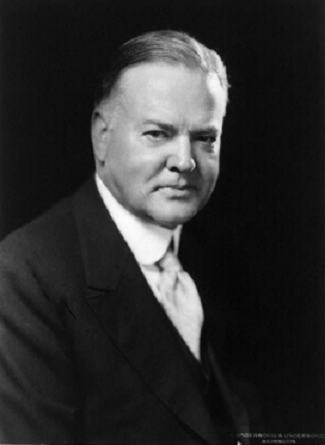
Herbert Hoover
31. Republican - Herbert Hoover / Charles Curtis - March 4, 1929 to March 4, 1933
- Hoover Dam: The administration oversaw the construction of the Hoover Dam, a monumental engineering project that provided hydroelectric power, flood control, and irrigation benefits to the Southwest United States.
- Agricultural Marketing Act: President Hoover signed the Agricultural Marketing Act, which established the Federal Farm Board and aimed to stabilize agricultural prices and support farmers during the Great Depression.
- Immigration Act of 1929: The administration worked to reform immigration policies with the Immigration Act of 1929, establishing visa quotas based on nationality and laying the groundwork for future immigration regulations.
- Federal Home Loan Bank Act: President Hoover signed the Federal Home Loan Bank Act, which established a system of regional banks to provide loans and support for home ownership and mortgage lending.
- Hoover Institution: The administration facilitated the creation of the Hoover Institution on War, Revolution, and Peace, a research institution focused on studying political, economic, and social issues.
- Air Commerce Act of 1926: The administration passed the Air Commerce Act, which paved the way for the regulation and development of commercial aviation in the United States.
- Veterans Administration: The administration consolidated and expanded various veteran support programs, leading to the creation of the Veterans Administration, which provided medical care, pensions, and other services to veterans.
- Hoover-Stimson Doctrine: The administration adopted the Hoover-Stimson Doctrine, which refused to recognize territorial changes resulting from Japan’s invasion of Manchuria, expressing opposition to aggression and a commitment to the principles of international law.
- Creation of the Reconstruction Finance Corporation: President Hoover established the Reconstruction Finance Corporation (RFC) to provide financial support to banks, railroads, and other businesses during the Great Depression.
- International Efforts for Economic Cooperation: The administration worked towards international economic cooperation, hosting the London Economic Conference and promoting cooperation through the League of Nations.
- Great Depression: The administration faced significant criticism for its handling of the Great Depression, with the economic downturn deepening during Hoover’s presidency.
- Stock Market Crash of 1929: The administration was unable to prevent or effectively respond to the stock market crash of 1929, which triggered the onset of the Great Depression.
- Limited Government Intervention: President Hoover’s emphasis on limited government intervention during the early years of the Great Depression drew criticism for a perceived lack of action to address economic hardships.
- Bonus Army Incident: The administration’s handling of the Bonus Army, a group of World War I veterans demanding early payment of bonuses, resulted in a violent confrontation and public criticism.
- Smoot-Hawley Tariff Act: President Hoover signed the Smoot-Hawley Tariff Act, which raised tariffs on imported goods, contributing to a decline in international trade and exacerbating the effects of the Great Depression.
- Homelessness and Poverty: The administration faced criticism for its perceived failure to adequately address homelessness and widespread poverty during the Great Depression.
- Economic Downturn in Agriculture: Despite efforts such as the Agricultural Marketing Act, the agricultural sector continued to suffer from falling prices, foreclosures, and widespread hardship.
- Unemployment Relief Efforts: The administration’s attempts to alleviate unemployment through voluntary cooperation and public-private initiatives fell short, with unemployment rates remaining high.
- Opposition to Direct Relief: President Hoover initially resisted direct federal relief programs, instead advocating for local and private efforts to address the economic crisis, which drew criticism for a lack of sufficient assistance to those in need.
- Loss of Public Confidence: The administration’s perceived inability to effectively address the economic crisis led to a loss of public confidence and contributed to Hoover’s defeat in the 1932 presidential election.
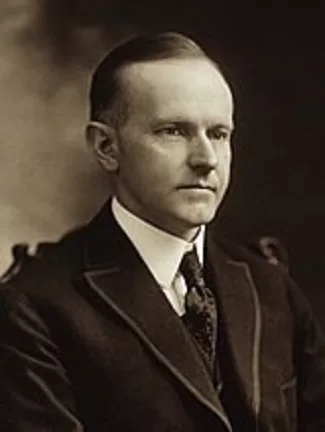
Calvin Coolidge
30. Republican - Calvin Coolidge August 2, 1923 to March 4, 1929 / Charles G. Dawes - Vacant until March 4, 1925 to March 4, 1929
- Economic Prosperity: Coolidge’s administration oversaw a period of economic growth and prosperity known as the “Roaring Twenties,” characterized by low unemployment rates, increased industrial production, and rising living standards.
- Tax Cuts: Coolidge signed into law the Revenue Act of 1924 and the Revenue Act of 1926, which reduced income tax rates and simplified the tax code, stimulating economic activity and investment.
- Budget Surpluses: Under Coolidge’s leadership, the federal government consistently achieved budget surpluses, reducing the national debt and promoting fiscal stability.
- Immigration Restriction: Coolidge signed the Immigration Act of 1924, also known as the Johnson-Reed Act, which imposed stricter immigration quotas and marked a significant shift towards restrictive immigration policies.
- Business Deregulation: The administration pursued a policy of limited government intervention and reduced regulations on businesses, aiming to foster a favorable environment for economic growth and innovation.
- Indian Citizenship Act: Coolidge signed the Indian Citizenship Act of 1924, granting citizenship to Native Americans born within the United States, recognizing their full rights as American citizens.
- Kellogg-Briand Pact: The administration played a key role in negotiating the Kellogg-Briand Pact, a multilateral treaty that renounced war as an instrument of national policy, promoting peace and disarmament.
- Aviation Advancements: Coolidge supported the rapid development of aviation, signing the Air Commerce Act of 1926, which regulated commercial aviation and established safety standards for the industry.
- Labor Relations: The administration generally pursued a policy of non-interference in labor disputes, allowing for increased autonomy and self-governance within labor unions.
- Reduction in National Debt: Coolidge prioritized debt reduction and succeeded in reducing the national debt from about $22.3 billion in 1923 to approximately $16.9 billion by the end of his presidency.
- Great Mississippi Flood of 1927: The administration faced criticism for its response to the Great Mississippi Flood, with some accusing the federal government of insufficient relief efforts and coordination.
- Limited Response to Racial Injustices: Coolidge’s administration did little to address racial inequalities and the pervasive discrimination faced by African Americans, particularly in the South.
- Income Inequality: While the Coolidge era saw economic growth, it also witnessed increasing income inequality, with the benefits of prosperity disproportionately favoring the wealthy.
- Weak Regulation of Stock Market: The administration did not take significant steps to regulate the stock market, contributing to the speculative excesses that led to the stock market crash of 1929.
- Agricultural Crisis: The agricultural sector faced significant challenges during Coolidge’s presidency, including falling commodity prices, declining farm incomes, and an increasing number of farm foreclosures.
- Lack of Action on Civil Rights: The administration took little action to advance civil rights or combat racial discrimination, failing to address systemic racial injustices of the era.
- Failure to Support Workers’ Rights: Coolidge’s administration did not prioritize the protection of workers’ rights or support legislation that would enhance labor rights and working conditions.
- Limited Action on Prohibition: Despite widespread violations and the growth of organized crime during Prohibition, Coolidge’s administration did not take significant action to address the negative consequences of the policy.
- Failure to Prevent the Stock Market Crash: The administration did not implement sufficient regulations or take proactive measures to prevent the speculative bubble that led to the stock market crash of 1929 and the subsequent Great Depression.
- Lack of International Engagement: Coolidge’s administration pursued a policy of limited international engagement, often prioritizing isolationism over active participation in global affairs.
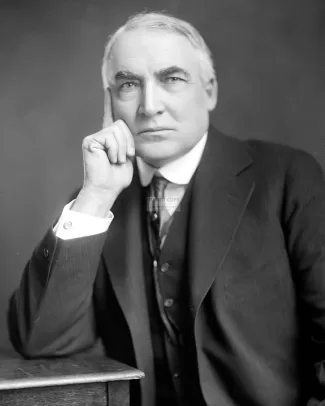
William G. Harding
29. Republican - Warren G. Harding / Calvin Coolidge - March 4, 1921 to August 2, 1923
- Economic Recovery: Harding’s administration implemented policies that helped the United States recover from the post-World War I recession, leading to a period of economic growth and increased industrial production.
- Reduction in Taxes: The administration passed the Revenue Act of 1921, which significantly reduced income tax rates, stimulating economic activity and encouraging investment.
- Disarmament Efforts: Harding played a key role in international disarmament efforts, particularly with the Washington Naval Conference of 1921-1922, which aimed to limit naval armaments among major powers.
- Fordney-McCumber Tariff Act: Harding signed the Fordney-McCumber Tariff Act of 1922, which raised tariff rates on imported goods, protecting domestic industries but contributing to a decline in international trade.
- Veterans’ Benefits: The administration expanded benefits and support for World War I veterans, including the passage of the Veterans’ Bureau Act of 1921 and the creation of the Veterans’ Bureau to address their needs.
- Pro-Business Policies: Harding’s administration pursued pro-business policies, advocating for limited government intervention and reduced regulations to encourage economic growth and entrepreneurship.
- Agriculture and Farm Relief: Harding supported legislation to provide relief to struggling farmers, including the Capper-Volstead Act of 1922, which allowed agricultural cooperatives to collectively market their products.
- Radio Regulation: The administration played a significant role in regulating the radio industry, signing the Radio Act of 1927, which established the Federal Radio Commission (later the Federal Communications Commission) to manage and oversee broadcasting.
- Infrastructure Development: Harding supported infrastructure development initiatives, including federal funding for road construction and improvements, which contributed to the expansion of the highway system.
- Normalization of Diplomatic Relations: The administration successfully worked towards the normalization of diplomatic relations with countries such as Germany, Austria, and Hungary, after their involvement in World War I.
- Teapot Dome Scandal: The administration was marred by the Teapot Dome Scandal, in which government officials were involved in corrupt practices related to the leasing of federal oil reserves, tarnishing Harding’s reputation.
- Mismanagement and Corruption: The Harding administration faced allegations of widespread corruption and mismanagement, with several high-level officials implicated in scandals and unethical practices.
- Lack of Oversight: Harding’s leadership style, characterized by delegating significant authority to his subordinates, contributed to a lack of proper oversight and allowed corrupt activities to flourish.
- Limited Progress on Civil Rights: The administration did not make significant advancements in addressing racial inequality or promoting civil rights for African Americans, failing to address the systemic discrimination of the era.
- Immigration Restriction: Harding signed the Emergency Quota Act of 1921, which imposed restrictive quotas on immigration based on nationality, marking a significant shift towards more restrictive immigration policies.
- Weak Labor Relations: The administration took a stance favoring businesses over labor unions, failing to effectively address workers’ rights or support labor reforms.
- Lack of Progress on Women’s Rights: Harding’s administration did not prioritize or achieve significant advancements in women’s rights, and the Equal Rights Amendment failed to gain sufficient support during this period.
- Economic Disparities: While the overall economy experienced growth, income inequality persisted, with the benefits of prosperity disproportionately favoring the wealthy.
- Limited Environmental Conservation: The administration did not prioritize environmental conservation efforts, and policies often favored economic interests over environmental protection.
- Health Challenges and Premature Death: Harding’s presidency was cut short by his sudden death in 1923, leaving several initiatives unfinished and contributing to a sense of instability in the administration.

Woodrow Wilson
28. Democratic - Woodrow Wilson / Thomas R. Marshall - March 4, 1913 to March 4, 1921
- Leadership during World War I: Wilson successfully led the United States through World War I, mobilizing the nation’s resources and coordinating efforts with Allied powers to secure victory.
- Creation of the Federal Reserve System: Wilson signed the Federal Reserve Act of 1913, establishing the Federal Reserve System, which brought stability to the U.S. banking system and provided a framework for monetary policy.
- Women’s Suffrage: Wilson supported and advocated for women’s suffrage, and the 19th Amendment to the U.S. Constitution, granting women the right to vote, was ratified during his administration.
- Establishment of the Federal Trade Commission: Wilson signed the Federal Trade Commission Act of 1914, creating the Federal Trade Commission (FTC) to regulate unfair business practices and promote fair competition.
- Tariff Reform: Wilson successfully championed the passage of the Underwood-Simmons Act of 1913, which significantly reduced tariff rates, promoting international trade and economic growth.
- Progressive Reforms: The Wilson administration advanced progressive reforms, including child labor laws, workplace safety regulations, and the creation of the Clayton Antitrust Act to strengthen antitrust enforcement.
- Income Tax: Wilson signed the Revenue Act of 1913, introducing a progressive income tax system that increased revenue and reduced the burden on lower-income individuals.
- Treaty of Versailles and League of Nations: Wilson played a key role in negotiating the Treaty of Versailles, which ended World War I, and advocated for the establishment of the League of Nations to promote international cooperation and peace.
- Federal Farm Loan Act: Wilson signed the Federal Farm Loan Act of 1916, providing low-interest loans to farmers and establishing the Farm Credit System to support agricultural financing.
- Anti-Corruption Measures: Wilson implemented measures to combat corruption and improve government efficiency, including the creation of the U.S. Civil Service Commission and the passage of the Clayton Antitrust Act.
- Failure to Secure Senate Ratification of the Treaty of Versailles: Despite his efforts, Wilson failed to secure Senate ratification of the Treaty of Versailles and U.S. membership in the League of Nations, limiting their effectiveness.
- Racial Segregation: Wilson’s administration enforced policies that promoted racial segregation within the federal government, rolling back some progress made by previous administrations.
- Suppression of Civil Liberties: During World War I, Wilson’s administration enforced strict measures to suppress dissent and curtail civil liberties, including the Espionage Act of 1917 and the Sedition Act of 1918.
- Poor Handling of Post-War Reconstruction: The Wilson administration faced challenges in effectively managing the post-war reconstruction period, both domestically and internationally, leading to political instability and economic disruptions.
- Limited Progress on Civil Rights: While Wilson advocated for progressive reforms, his administration did not make significant advancements in addressing racial inequalities or promoting civil rights for African Americans.
- Controversial Intervention in Latin America: Wilson’s administration intervened militarily in several Latin American countries, including Haiti, the Dominican Republic, and Mexico, leading to strained relations and criticism.
- Opposition to Progressive Labor Reforms: Wilson’s administration faced criticism for its opposition to certain labor reforms, including the unsuccessful attempt to pass the Adamson Act, which aimed to establish an eight-hour workday for railroad workers.
- Economic Challenges: The Wilson administration grappled with economic challenges, including inflation, labor strikes, and disruptions caused by World War I, which impacted the overall stability and prosperity of the nation.
- Limited Success in Foreign Policy: While Wilson championed international cooperation and peace, his administration faced difficulties in achieving significant breakthroughs in international diplomacy and resolving conflicts.
- Health Challenges and Limited Governance: Wilson’s health deteriorated during his second term, and he became less engaged in governance, leading to a perceived lack of strong leadership and decision-making.
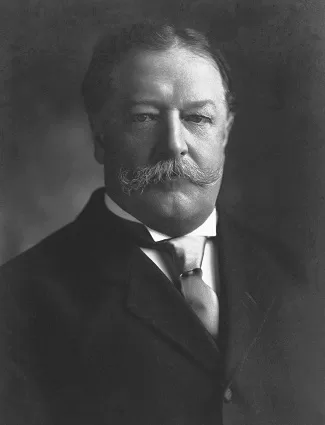
William Howard Taft
27. Republican - William Howard Taft - March 4, 1909 to March 4, 1913 / James S. Sherman - March 4, 1909 to October 30, 1912
- Trust-Busting: Taft continued the trust-busting efforts of his predecessor, Theodore Roosevelt, and successfully pursued antitrust cases against several major corporations, including the Standard Oil Company and the American Tobacco Company.
- Expansion of Conservation Efforts: Taft significantly expanded the national conservation program, adding more land to national forests and national parks, including the establishment of the Bureau of Mines to oversee mineral resources.
- Postal Savings System: Taft signed the Postal Savings Act of 1910, creating the Postal Savings System, which allowed Americans to deposit money in post offices, promoting savings and financial stability.
- Diplomatic Relations: The Taft administration made efforts to improve diplomatic relations with Latin American countries, often referred to as “dollar diplomacy,” which aimed to foster economic cooperation and stability.
- Payne-Aldrich Tariff: Although controversial, Taft signed the Payne-Aldrich Tariff Act of 1909, which aimed to lower tariff rates but faced criticism for not doing enough to reduce protectionism.
- Railway Safety Regulations: The administration pursued legislation to improve railway safety regulations, including the creation of the Federal Safety Appliance Act and the Hours of Service Act.
- Expansion of Foreign Trade: Taft actively pursued and negotiated trade agreements with foreign nations, expanding U.S. trade and promoting economic growth.
- Judicial Appointments: Taft appointed several notable jurists to the federal judiciary, including Edward Douglass White as Chief Justice of the Supreme Court, who played a significant role in shaping constitutional law.
- Government Efficiency: Taft implemented measures to improve government efficiency and modernize administrative practices, such as reorganizing departments and establishing a budget system.
- Income Tax Amendments: Taft supported and signed the 16th Amendment, allowing for the federal income tax, and the 17th Amendment, which established the direct election of senators.
- Republican Party Divisions: Taft faced significant divisions within the Republican Party, particularly with Theodore Roosevelt’s Progressive Party (Bull Moose Party), leading to a split in support and ultimately impacting his reelection bid.
- Inability to Satisfy Progressive Reformers: Taft’s presidency faced criticism from progressive reformers who believed he did not go far enough in implementing progressive policies and regulations.
- Ballinger-Pinchot Controversy: The administration faced a controversy surrounding the actions of Secretary of the Interior Richard Ballinger and the subsequent firing of Gifford Pinchot, head of the U.S. Forest Service, leading to public criticism and loss of support.
- Strained Labor Relations: Taft struggled to navigate labor relations during a period of significant labor unrest and strikes, leading to challenges in finding a balance between the interests of workers and business owners.
- Impact of the Panic of 1907: The Taft administration faced economic challenges stemming from the aftermath of the Panic of 1907, which contributed to a period of economic uncertainty and financial instability.
- Lack of Consistent Foreign Policy: The administration faced criticism for its perceived lack of a consistent and coherent foreign policy approach, particularly regarding U.S. interventions in Latin America.
- Limited Progress on Civil Rights: Taft’s administration did not make significant advancements in addressing racial inequalities or promoting civil rights for African Americans.
- Failure to Secure Conservation Measures: While Taft expanded conservation efforts, he faced criticism for not doing enough to protect certain environmentally sensitive areas, such as the Hetch Hetchy Valley in Yosemite National Park.
- Congressional Opposition: Taft encountered challenges in working with Congress, particularly with a divided Republican Party and opposition from Democratic lawmakers.
- Lack of Charisma and Public Appeal: Taft’s reserved personality and lack of strong public appeal contributed to difficulties in garnering widespread public support and maintaining political momentum.
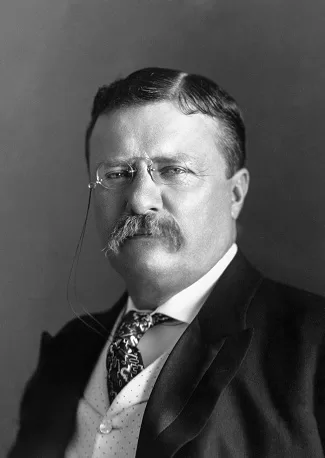
Theodore Roosevelt
26. Republican - Theodore Roosevelt - September 14, 1901 to March 4, 1909 / Charles W. Fairbanks - Vacant to March 4, 1905 to March 4, 1909
- New Deal Programs: Roosevelt’s administration implemented a series of programs known as the New Deal, aimed at combating the Great Depression and providing relief, recovery, and reform. This included the establishment of the Civilian Conservation Corps (CCC), the Works Progress Administration (WPA), the Social Security Act, and the Tennessee Valley Authority (TVA).
- Leadership during World War II: Roosevelt successfully led the United States through World War II, mobilizing the country’s resources and forming alliances with Allied powers to defeat the Axis powers.
- Creation of the FDIC: Roosevelt signed the Banking Act of 1933, which established the Federal Deposit Insurance Corporation (FDIC), providing stability to the banking system and protecting depositors’ funds.
- Expansion of the Federal Government: Roosevelt significantly expanded the role of the federal government through the New Deal programs, bringing about a fundamental shift in the government’s responsibility for social welfare and economic regulation.
- Relief and Recovery for Farmers: The administration implemented agricultural policies, such as the Agricultural Adjustment Act (AAA) and the Rural Electrification Administration (REA), aimed at stabilizing farm incomes and improving rural infrastructure.
- Leadership in International Relations: Roosevelt played a key role in shaping international relations, including the establishment of the United Nations and the initiation of the Lend-Lease program to support Allied nations during World War II.
- Pro-Labor Policies: Roosevelt supported pro-labor policies, including the National Labor Relations Act (NLRA), also known as the Wagner Act, which protected workers’ rights to organize and bargain collectively.
- Social Security System: The Social Security Act of 1935, signed by Roosevelt, established the social security system in the United States, providing retirement benefits, unemployment insurance, and assistance for the disabled and low-income individuals.
- Infrastructure Development: The New Deal included significant investments in infrastructure projects, such as the construction of roads, bridges, and public buildings, providing jobs and improving the nation’s infrastructure.
- Improved Public Confidence: Through his fireside chats and effective communication, Roosevelt instilled confidence in the American people, helping restore trust in the government and providing a sense of hope during difficult times.
- Japanese Internment: The Roosevelt administration authorized the internment of Japanese Americans during World War II, leading to the violation of civil liberties and the unjust treatment of innocent individuals.
- Slow Recovery from the Great Depression: Despite the implementation of various New Deal programs, the economy experienced a slow recovery from the Great Depression, and unemployment remained high for an extended period.
- Opposition to the New Deal: Roosevelt faced opposition from conservatives and business interests who criticized the New Deal programs as excessive government intervention and overreach.
- Limited Progress on Civil Rights: While Roosevelt took some steps to address racial inequalities, progress on civil rights for African Americans was limited during his presidency, and racial segregation persisted.
- Court-Packing Plan: Roosevelt’s proposal to expand the Supreme Court and pack it with additional justices to overcome opposition to his New Deal policies was met with significant public and political backlash and was ultimately unsuccessful.
- Economic Challenges during World War II: The transition from a peacetime economy to a wartime economy presented significant economic challenges, including inflation, rationing, and disruptions in civilian industries.
- Failure to Pass Anti-Lynching Legislation: Despite public support for anti-lynching legislation, Roosevelt was unable to secure its passage through Congress.
- Limited Response to Holocaust Refugees: The Roosevelt administration faced criticism for its limited response to the plight of Jewish refugees fleeing Nazi persecution during World War II.
- Racial Discrimination in New Deal Programs: Some New Deal programs perpetuated racial discrimination, with African Americans and other minority groups facing unequal treatment and limited access to relief and employment opportunities.
- Initial Reluctance to Enter World War II: While Roosevelt eventually led the United States into World War II after the attack on Pearl Harbor, his administration initially faced criticism for its reluctance to engage in the conflict despite escalating tensions in Europe and Asia.
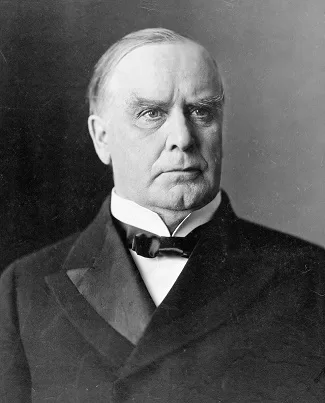
William McKinley
25. Republican - William McKinley - March 4, 1897 to September 14, 1901 / Garret Hobart - March 4, 1897 to November 21, 1899, Theodore Roosevelt - March 4, 1901 to September 14, 1901
- Spanish-American War: The administration successfully led the country through the Spanish-American War in 1898, resulting in the acquisition of territories such as Puerto Rico, Guam, and the Philippines, and establishing the United States as a global power.
- Economic Growth and Prosperity: Under McKinley’s presidency, the country experienced a period of economic growth and industrial expansion, known as the “McKinley Prosperity,” with increased industrial production, rising wages, and low unemployment rates.
- Gold Standard Act: McKinley signed the Gold Standard Act in 1900, establishing the gold standard as the official monetary policy of the United States, which contributed to a stable currency and facilitated economic growth.
- Expansion of U.S. Influence: The McKinley administration pursued an active foreign policy, expanding U.S. influence and establishing favorable trade relations with countries around the world, particularly in Asia and Latin America.
- Annexation of Hawaii: McKinley supported the annexation of Hawaii in 1898, bringing the islands under U.S. control and paving the way for Hawaii to become a U.S. territory.
- Tariff Reform: The administration enacted the Dingley Tariff Act of 1897, which raised tariff rates to protect American industries and generate revenue for the government.
- Infrastructure Development: McKinley promoted infrastructure development, including the expansion of the nation’s railroads, which facilitated trade and economic growth.
- Election Reform: The administration supported election reforms, including the passage of the Federal Election Campaign Act of 1907, which aimed to regulate campaign financing and promote transparency.
- Negotiation of Commercial Treaties: McKinley’s administration negotiated several commercial treaties, including the Hay-Pauncefote Treaty, which gave the United States the exclusive right to build and control a canal in Panama.
- Social Reforms: McKinley supported various social reforms, including the creation of the National Civic Federation, which aimed to promote industrial harmony and improve labor conditions.
- Assassination: The biggest failure of McKinley’s administration was the assassination of President McKinley in 1901, which cut short his presidency and his potential future achievements.
- Populist Unrest: The administration faced significant unrest and political challenges from populist movements, such as the Farmers’ Alliance and the Populist Party, which advocated for agrarian and labor reforms.
- Labor Unrest: The country experienced several labor strikes and conflicts during McKinley’s presidency, including the Pullman Strike in 1894 and the Coal Strike of 1902, which posed challenges to industrial relations.
- Anti-Imperialist Opposition: The administration faced criticism and opposition from anti-imperialist groups who opposed the U.S. acquisition of overseas territories and believed it contradicted American values.
- Response to the Philippine Insurrection: The administration struggled to address the Philippine Insurrection, a violent conflict that arose following the U.S. acquisition of the Philippines, resulting in significant casualties and challenges in establishing stability.
- Racial Discrimination: African Americans faced continued discrimination and disenfranchisement during McKinley’s presidency, particularly in the southern states.
- Lack of Progressive Reforms: McKinley’s administration did not pursue significant progressive reforms, which disappointed some reform-minded individuals and groups.
- Trusts and Monopolies: The administration faced criticism for its perceived inaction in regulating trusts and monopolistic practices, which led to concerns about concentration of economic power.
- Limited Action on Civil Rights: While McKinley expressed support for civil rights, his administration did not take significant steps to address racial inequalities and protect the rights of African Americans.
- Limited Response to Labor Issues: The administration faced criticism for its limited response to labor issues, particularly in terms of protecting workers’ rights and improving labor conditions.
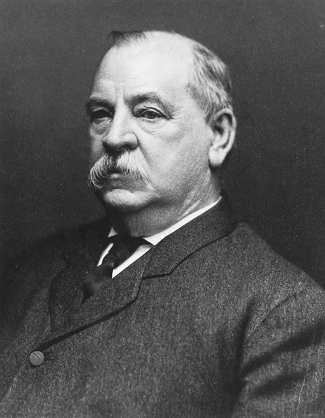
Grover Cleveland
24. Democratic - Grover Cleveland / Adlai Stevenson I - March 4, 1893 to March 4, 1897
- Civil Service Reform: Cleveland was a staunch advocate of civil service reform, and during his first term, he worked to reduce political patronage in government appointments and increase the number of government positions based on merit.
- Veto of Private Pension Bills: Cleveland exercised his veto power to reject numerous private pension bills for Civil War veterans, which demonstrated his commitment to fiscal responsibility and preventing fraudulent claims.
- Interstate Commerce Act: Cleveland signed the Interstate Commerce Act of 1887 into law, which was the first significant federal regulation of businesses, aimed at addressing issues related to railroads and ensuring fair rates and practices.
- Veto of Texas Seed Bill: In 1887, Cleveland vetoed a bill that would have provided drought relief to Texas farmers, believing that such federal aid was not constitutionally authorized.
- Reform of Public Lands Policy: Cleveland took steps to reform public lands policy, which included restoring millions of acres of land to the public domain and combating land fraud and corruption.
- Foreign Policy Success: Cleveland’s administration successfully negotiated the Halibut Treaty with Great Britain in 1887, establishing fishing rights and resolving disputes in the North Pacific region.
- Reduction of National Debt: Under Cleveland’s first presidency, the national debt was significantly reduced due to his commitment to fiscal conservatism and responsible government spending.
- Labor Relations: Cleveland’s administration worked to mediate labor disputes and improve relations between workers and employers, earning some praise for its handling of labor issues.
- Veto of Dependent Pension Bill: In 1887, Cleveland vetoed a bill that would have granted pensions to dependents of deceased Civil War veterans, citing concerns about fraudulent claims and pension abuses.
- Preservation of Presidential Vetoes: Cleveland used his veto power more than any other president up to that time, preserving the integrity of the presidential veto as a tool to check legislative excesses.
- Economic Recession: Cleveland faced the fallout from the Panic of 1884, which was a severe economic recession that began shortly after he took office in 1885. His administration grappled with economic hardships and high unemployment rates.
- Civil Service Reform Struggles: While Cleveland was an advocate for civil service reform, he faced challenges in implementing a merit-based system due to resistance from the patronage-driven “spoils system” entrenched in the government.
- Veto of Pension Legislation: Cleveland used his veto power to reject numerous private pension bills for Civil War veterans, which resulted in political backlash and criticism from some veterans’ groups.
- Limited Support from Congress: The Democratic president faced difficulties in gaining support from a Republican-controlled Congress, which hindered his ability to pass key legislation.
- Issues with Tariff Reform: Cleveland’s push for tariff reduction faced opposition from protectionist interests and industries that relied on high tariffs for protection.
- Haymarket Riot and Labor Unrest: In 1886, the Haymarket Riot in Chicago and other labor unrest incidents led to tensions between workers and employers. The administration had to navigate these issues and address demands for labor rights.
- Handling of the Railroad Strike of 1886: Cleveland’s decision to use federal troops to break the Great Southwest Railroad Strike of 1886 led to criticism and accusations of siding with business interests over workers.
- Land Policy Challenges: Cleveland faced challenges in managing land policies, including disputes over public land use and conservation efforts.
- Relations with Native Americans: The administration’s policies towards Native Americans, including the Dawes Severalty Act, had negative consequences for many tribes and led to the loss of communal land.
- Distrust among Party Factions: Internal divisions within the Democratic Party posed challenges for the administration and affected its ability to push forward key initiatives.
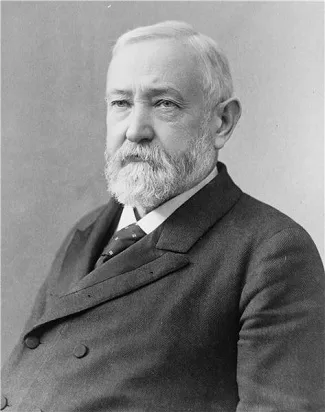
Benjamin Harrison
23. Republican - Benjamin Harrison / Levi P. Morton - March 4, 1889 to March 4, 1893
- Sherman Antitrust Act: Harrison signed the Sherman Antitrust Act into law in 1890, aimed at promoting fair competition in business and regulating monopolistic practices.
- Expansion of the Navy: President Harrison advocated for the expansion and modernization of the U.S. Navy, which laid the groundwork for future naval growth and preparedness.
- Landmark Legislation: Under Harrison’s administration, Congress passed several important pieces of legislation, including the McKinley Tariff Act and the Sherman Silver Purchase Act.
- Yellowstone National Park Protection: In 1891, Harrison signed a bill into law that established the National Forest Reserve (later known as the National Park System), setting aside over 13 million acres of public land for conservation and recreational use.
- Pension Act for Civil War Veterans: The Dependent and Disability Pension Act of 1890 significantly expanded pension benefits for Civil War veterans and their dependents.
- Record Number of Federal Appointments: Harrison made numerous federal appointments during his term, including six Supreme Court justices, more than any other president in a single term.
- Record Number of Territories Admitted: Under Harrison’s administration, six territories were admitted to statehood, including North Dakota, South Dakota, Montana, Washington, Idaho, and Wyoming.
- Strengthening Diplomatic Ties: Harrison worked to improve diplomatic relations with Latin American countries, fostering stronger ties with Central and South American nations.
- Enforcement of Voting Rights: The Harrison administration took action to enforce voting rights for African Americans in the South, which had been curtailed during the Reconstruction era.
- Initiatives for Civil Rights: Harrison advocated for legislation aimed at protecting the civil rights of African Americans and addressing issues related to racial discrimination.
- Economic Depression: The Panic of 1893 occurred during Harrison’s term and led to a severe economic depression. The administration faced difficulties in addressing the economic downturn and its impact on the American people.
- Agricultural Crisis: The 1890s witnessed a serious agricultural depression, which affected farmers across the country. The Harrison administration faced challenges in finding effective solutions to address this crisis.
- Sherman Silver Purchase Act: While it was an achievement to pass this legislation, the act contributed to the economic difficulties and instability that followed, particularly in relation to the gold-silver ratio and the nation’s currency system.
- Labor Unrest: The late 19th century saw significant labor unrest, with strikes and protests across various industries. The administration faced challenges in managing labor disputes and upholding workers’ rights.
- Congressional Opposition: Harrison faced difficulties in advancing his policy agenda due to opposition from a Democratic-controlled Congress.
- Controversial Indian Policies: The administration’s approach to Native American policies faced criticism, particularly the Dawes Severalty Act, which led to the loss of communal land and cultural disruption for many tribes.
- Inaction on Civil Rights: While some initiatives were proposed, Harrison’s administration made limited progress in advancing civil rights for African Americans.
- Veterans’ Pension Inflation: The Dependent and Disability Pension Act, while providing benefits to Civil War veterans, led to inflation in veterans’ pensions and increased government spending.
- Failure to Secure Reciprocal Trade Agreements: Harrison’s efforts to secure reciprocal trade agreements with Latin American countries were not successful, potentially hindering economic growth.
- Limited Impact on Foreign Policy: The administration faced difficulties in achieving significant foreign policy successes, particularly with regards to international relations and trade agreements.

Grover Cleveland
22. Democratic - Grover Cleveland - March 4, 1885 to March 4, 1889 / Thomas A. Hendricks - March 4, 1885 to November 25, 1885
- Tariff Repeal: Cleveland successfully advocated for the repeal of the Sherman Silver Purchase Act, which contributed to further economic stability and restored confidence in the gold standard.
- Wilson-Gorman Tariff: Although not as extensive as he had hoped, Cleveland’s administration succeeded in enacting the Wilson-Gorman Tariff Act of 1894, which reduced tariffs on some goods and introduced an income tax.
- Resolve of the Pullman Strike: Cleveland’s use of federal troops to end the Pullman Strike of 1894 helped restore rail transportation and demonstrated his willingness to take decisive action during labor unrest.
- Conservation Efforts: Cleveland expanded federal conservation efforts by creating the Sierra Forest Reserve (later known as the Sierra National Forest) in California in 1893.
- Trade Negotiations with Latin America: The administration pursued reciprocal trade agreements with Latin American countries, aiming to enhance economic relations with neighboring nations.
- Preservation of Presidential Vetoes: Cleveland continued to use his veto power to maintain the integrity of the presidential veto as a check on legislative actions.
- Diplomatic Relations with Hawaii: Cleveland worked to address issues surrounding Hawaii’s monarchy and U.S. influence, setting the stage for later developments regarding Hawaiian annexation.
- Sound Monetary Policy: The administration’s adherence to the gold standard and efforts to maintain fiscal stability contributed to restoring economic confidence.
- Reduction of National Debt: Cleveland’s second term saw a continued reduction in the national debt, reflecting his commitment to fiscal conservatism.
- Restored Presidency’s Integrity: Cleveland’s second presidency helped restore the public’s perception of the presidency after a series of tumultuous administrations, and he left the White House with his personal integrity intact.
- Economic Depression: Cleveland faced the Panic of 1893, a severe economic depression that began shortly after he took office in 1893. The economic downturn resulted in widespread unemployment and business failures.
- Labor Unrest and Pullman Strike: The Pullman Strike of 1894 led to significant labor unrest, with the federal government intervening to quell the strike. Cleveland’s handling of the situation drew criticism from both labor and business interests.
- Failure to Address Economic Crisis: Despite his efforts, Cleveland struggled to effectively address the economic depression and implement measures to alleviate its impact on the American people.
- Repeal of the Sherman Silver Purchase Act: Cleveland’s push for the repeal of the Sherman Silver Purchase Act in 1893 contributed to further economic instability, particularly for silver mining interests and proponents of bimetallism.
- Backlash Against Tariff Policy: Cleveland’s pursuit of tariff reduction, as seen in the Wilson-Gorman Tariff Act of 1894, was met with opposition and ultimately fell short of significant tariff reform.
- Populist and Agrarian Unrest: The economic depression and perceived failure to address agrarian and populist concerns contributed to increased unrest among farmers and laborers.
- Failure to Address Civil Rights: Cleveland made limited progress in advancing civil rights for African Americans and other marginalized communities during his second term.
- Distrust from His Own Party: Cleveland’s economic policies, particularly regarding currency and tariffs, led to divisions within the Democratic Party and strained his relationship with some party members.
- Pension Veto Controversy: Cleveland’s veto of a pension bill for Civil War veterans in 1894 sparked controversy and further strained his relationship with some veterans’ groups.
- International Trade Difficulties: The administration faced challenges in achieving favorable trade agreements and addressing economic issues with foreign countries, particularly in Latin America.
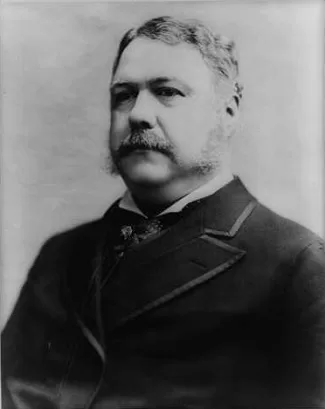
Chester A. Arthur
21. Republican - Chester A. Arthur - September 19, 1881 to March 4, 1885 / Vacant throughout presidency
- Civil Service Reform: Arthur supported and signed the Pendleton Civil Service Reform Act of 1883, which marked a significant step toward replacing the patronage system with a merit-based civil service system.
- Modernization of the Navy: Arthur advocated for the modernization and expansion of the U.S. Navy, and during his presidency, he signed the Naval Appropriations Act of 1883, which authorized the construction of new warships.
- Reduction of Tariffs: Arthur pushed for tariff reform and signed the Tariff Act of 1883, which reduced tariff rates on certain goods.
- Immigration Restriction: The Chinese Exclusion Act of 1882, which was signed into law during Arthur’s presidency, restricted Chinese immigration to the United States.
- Infrastructure Investment: Arthur’s administration supported internal improvements and infrastructure development, including funding for harbor and river improvements.
- International Relations: Arthur’s presidency saw improved relations with Great Britain, marked by the successful resolution of the Alabama Claims dispute through the 1882 Treaty of Washington.
- Civil Rights Advocacy: Arthur advocated for civil rights and worked to ensure that freedmen in the South were granted equal protection under the law.
- Reconciliation and Unity: Arthur sought to heal the divisions between the Stalwart and Half-Breed factions within the Republican Party, fostering greater party unity.
- Veto of River and Harbor Bill: In 1882, Arthur exercised his veto power to reject an omnibus River and Harbor Bill that was laden with pork-barrel projects, demonstrating fiscal responsibility.
- Health and Sanitation Initiatives: Arthur signed the Quarantine Act of 1884, which aimed to improve health and sanitation standards for incoming ships and immigrants.
- Accusations of Political Patronage: Arthur faced accusations of cronyism and political patronage due to his association with the “Stalwart” faction of the Republican Party, which sought to reward loyal supporters with government positions.
- Pendleton Civil Service Reform Act: Arthur struggled with the implementation of civil service reform, despite endorsing the Pendleton Civil Service Act, which aimed to curb the spoils system.
- Immigration Policy: Arthur’s administration struggled to address the increasing influx of immigrants, leading to calls for restrictive immigration policies, particularly targeting Chinese immigrants.
- Economic Depressions: Arthur faced economic challenges during his presidency, including the fallout from the Panic of 1884, which led to an economic downturn.
- Labor Unrest: Arthur’s presidency saw several labor strikes and unrest, including the Great Southwest Railroad Strike of 1886, which led to violence and further strained labor relations.
- The Star Route Scandal: Arthur’s administration had to address the lingering effects of the Star Route Scandal, involving corrupt postal contractors, which had begun during the previous administration.
- Public Perception: Arthur struggled with low public approval ratings, with some viewing him as an accidental president who lacked a clear vision.
- Civil Rights Issues: Arthur’s response to civil rights issues, particularly regarding African Americans in the South, was seen by critics as insufficient.
- Indian Policy: Arthur’s administration faced challenges in implementing policies towards Native American tribes, often characterized by broken treaties and forced removals.
- Limited Impact on Domestic Policy: Arthur’s presidency did not achieve major domestic policy accomplishments, and some perceived his administration as being overshadowed by other political figures and events.
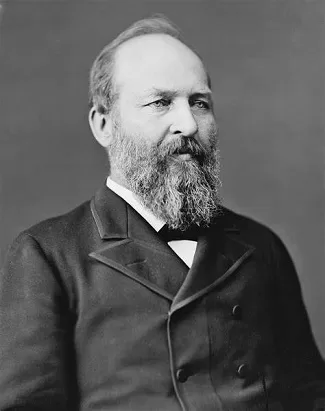
James A. Garfield
20. Republican - James A. Garfield / Chester A. Arthur - March 4, 1881 to September 19, 1881
- Civil Service Reform Advocacy: Garfield was a strong advocate for civil service reform and aimed to replace the spoils system with a merit-based system for government appointments.
- Foreign Policy Diplomacy: Garfield worked to improve foreign relations with European countries and Latin America, seeking opportunities for trade and diplomacy.
- Agricultural College Legislation: During his brief tenure, Garfield signed the Second Morrill Act into law, which provided federal funding for the establishment of agricultural colleges in the states.
- Advocacy for Civil Rights: Garfield publicly supported civil rights for African Americans and advocated for equal protection under the law.
- Efforts to Unite the Republican Party: As a compromise candidate, Garfield sought to unite the Republican Party factions after a contentious nominating convention.
- Support for Civil Service Commission: Garfield supported and reinforced the Civil Service Commission, which was established to oversee the implementation of civil service reform.
- Efforts to Reduce Patronage: Garfield attempted to reduce the spoils system and limit the influence of political patronage in government appointments.
- Sound Monetary Policy: Garfield advocated for sound monetary policy and sought to maintain fiscal responsibility.
- Improvement of U.S. Navy: Garfield’s administration aimed to modernize and strengthen the U.S. Navy.
- Advocacy for Education: Garfield was a proponent of education and worked to promote educational opportunities for all citizens.
- Political Patronage: Garfield faced challenges in managing political patronage, with factions within the Republican Party vying for government appointments and positions.
- Stalemate in Congress: Garfield struggled to navigate the political divisions and stalemate in Congress, making it difficult to advance his legislative agenda.
- Party Factionalism: The Republican Party was divided into factions, and Garfield had to deal with the competing interests and demands of different party members.
- Spoils System: Garfield inherited the spoils system, where government jobs were used as political rewards, and attempts at civil service reform had limited success during his presidency.
- Economic Challenges: Garfield’s administration faced economic challenges, including the aftermath of the Panic of 1873 and the economic downturn of the early 1880s.
- Foreign Policy Uncertainty: Garfield’s foreign policy initiatives were cut short, and his presidency did not have a chance to fully develop a coherent foreign policy direction.
- Post-Assassination Medical Care: After being shot by an assassin, Garfield received medical treatment that likely worsened his condition, leading to his eventual death.
- Shortened Presidency: Garfield’s assassination cut short what could have been a more substantial presidency, leaving many of his proposed policies and initiatives unfulfilled.
- Limited Impact on Legislation: Garfield’s presidency did not have sufficient time to achieve significant legislative accomplishments, given its brevity.
- Political Turmoil: The aftermath of Garfield’s assassination resulted in political turmoil and uncertainty, with Vice President Chester A. Arthur assuming the presidency under difficult circumstances.

Rutherford B. Hayes
19. Republican - Rutherford B. Hayes / William A. Wheeler - March 4, 1877 to March 4, 1881
- End of Reconstruction: Hayes’s presidency marked the end of Reconstruction in the South, as federal troops were withdrawn from the region, and the era of military occupation formally concluded.
- Civil Service Reform: Hayes was an early advocate for civil service reform and established a bipartisan Civil Service Commission to address issues of patronage and implement merit-based hiring practices.
- Currency Reform: Hayes worked to stabilize the nation’s currency by advocating for the resumption of specie payments, returning to the gold standard, and retiring Civil War-era greenbacks.
- Great Railroad Strike of 1877: During the labor unrest, Hayes took a measured approach by supporting the workers’ right to strike while also using federal troops to restore order and protect public property.
- Labor Relations: Hayes’s presidency saw the creation of the National Labor Bureau, which later evolved into the U.S. Department of Labor, reflecting his administration’s focus on labor issues.
- Education Advocacy: Hayes was a strong advocate for education and supported the creation of a national education association to promote educational standards and professional development for teachers.
- Advocacy for Civil Rights: Hayes supported civil rights for African Americans and Native Americans, working to protect their voting rights and advocating for equal protection under the law.
- Hawaiian Annexation: Hayes pursued negotiations with Hawaii for its annexation, setting the groundwork for future discussions on the matter.
- Naval Modernization: The Hayes administration began efforts to modernize and expand the U.S. Navy, enhancing its capabilities and preparedness.
- Protection of Public Lands: Hayes supported efforts to conserve and protect public lands, leading to the establishment of numerous national parks and forests during his tenure.
- Contentious Election: Hayes’s presidency began with a disputed election in 1876, leading to the Compromise of 1877, which ended Reconstruction and removed federal troops from the South, effectively ending efforts to protect the rights of African Americans.
- Economic Recession: Hayes’s presidency was marked by an economic recession that began in 1873 and persisted during much of his time in office, leading to financial hardships for many Americans.
- End of Reconstruction: The withdrawal of federal troops from the South and the end of Reconstruction allowed for the rise of Jim Crow laws and the suppression of civil rights for African Americans in the South.
- Civil Rights Issues: Hayes’s administration faced challenges in addressing civil rights issues and protecting the rights of African Americans in the face of increased discrimination and violence in the South.
- Compromise of 1877: While the Compromise of 1877 resolved the election dispute, it also led to the abandonment of federal efforts to protect African American rights and civil liberties in the South.
- Bland-Allison Act: Hayes vetoed the Bland-Allison Act, which aimed to increase the amount of silver in circulation, but Congress overrode his veto, leading to inflation concerns and economic instability.
- Labor Strikes: Hayes faced labor strikes during his presidency, including the Great Railroad Strike of 1877, which led to violent clashes between workers and the government.
- Relations with Native Americans: Hayes’s administration struggled with Native American policy, particularly concerning land rights and conflicts with Western tribes.
- Limitations on Presidential Power: Hayes faced challenges in exerting presidential authority, with Congress and political factions often thwarting his policy objectives.
- Limited Impact on Legislation: Hayes’s presidency faced difficulties in achieving significant legislative accomplishments due to the contentious political climate and opposition from Congress.
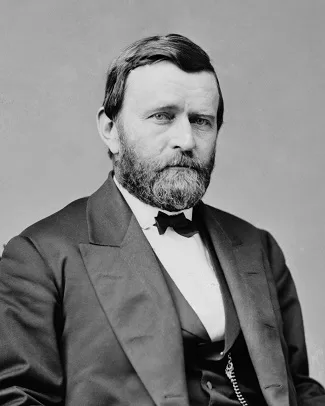
Ulysses S. Grant
18. Republican - Ulysses S. Grant - March 4, 1869, to March 4, 1877 / Schuyler Colfax 1868, Henry Wilson 1868-1872, vacant after November 22, 1875
- Reconstruction Policies: Grant’s administration worked to enforce Reconstruction policies in the South, promoting civil rights for African Americans and protecting their right to vote.
- 15th Amendment Ratification: During Grant’s presidency, the 15th Amendment to the U.S. Constitution was ratified, granting African American men the right to vote.
- Enforcement Acts: Grant signed into law the Enforcement Acts of 1870 and 1871, aimed at combating and preventing voter intimidation and suppressing violence against African American voters.
- Civil Service Reform: Grant established the Civil Service Commission to address issues of political patronage and promote merit-based hiring within the federal government.
- Fighting Corruption: Grant sought to combat corruption and fraud in government contracts, leading to several successful prosecutions of corrupt officials.
- Treaty of Washington: Grant’s administration successfully negotiated the Treaty of Washington in 1871, which resolved several longstanding disputes with Great Britain, including the Alabama Claims.
- Indian Peace Policy: Grant’s administration implemented a peace policy towards Native American tribes, promoting peaceful coexistence and cultural assimilation.
- Completion of the Transcontinental Railroad: The first transcontinental railroad was completed during Grant’s presidency, connecting the East and West coasts of the United States.
- Public Lands Preservation: Grant signed into law the Yellowstone National Park Protection Act in 1872, establishing the world’s first national park.
- Economic Growth: Grant’s presidency saw periods of economic growth and industrial development, particularly in the North and West.
- Corruption and Scandals: Grant’s administration was marred by numerous scandals, including the Whiskey Ring, Credit Mobilier, and the Black Friday Gold Panic, leading to allegations of corruption among some of his associates.
- Reconstruction and Civil Rights: While Grant supported civil rights for African Americans, Reconstruction efforts were hindered by violence, the rise of white supremacist groups, and the eventual withdrawal of federal troops from the South, leaving African Americans vulnerable to discrimination and disenfranchisement.
- Indian Policy: Grant’s administration struggled to implement a fair and effective policy towards Native American tribes, leading to conflicts and broken treaties.
- Panic of 1873: Grant’s second term was overshadowed by the economic downturn of the Panic of 1873, leading to widespread unemployment and financial hardship.
- Civil Service Reforms: Despite expressing support for civil service reforms, Grant’s administration faced challenges in implementing lasting changes to the patronage system.
- Relations with Congress: Grant’s presidency faced tensions and conflicts with Congress, hindering the implementation of his policy agenda.
- Enforcement Acts: While Grant signed the Enforcement Acts to protect voting rights for African Americans, they were not always effectively enforced, leaving African Americans vulnerable to voter intimidation and suppression.
- Relations with Native American Tribes: Grant’s policies towards Native American tribes were often marked by forced removals and broken treaties, leading to ongoing conflicts and hardships for indigenous peoples.
- Foreign Policy: Grant’s administration faced challenges in foreign relations, including tensions with Spain and conflicts in the Caribbean and Pacific.
- Second Term Turmoil: Grant’s second term was marked by political divisions and scandals, leading to a sense of turmoil and disillusionment among some Americans.

Andrew Johnson
17. National Union / Democratic - Andrew Johnson - April 15, 1865 to March 4, 1869 / Vice Presidency vacant throughout presidency
- Restoring Civil Government in the South: Johnson’s administration worked to reestablish civil government in the former Confederate states, facilitating their readmission into the Union.
- Amnesty Proclamations: Johnson issued several amnesty proclamations, pardoning many former Confederates, enabling them to participate in the political process again.
- Homestead Act of 1866: Johnson signed the Homestead Act of 1866, which expanded opportunities for western settlement by granting public land to homesteaders.
- Department of Justice Creation: Johnson signed legislation that established the Department of Justice, a crucial federal agency that plays a role in enforcing the laws of the United States.
- Veto of Civil Rights Act of 1866: Johnson’s veto of the Civil Rights Act of 1866 was a significant point of contention, as it sought to secure the civil rights of African Americans in the face of opposition from Johnson and other white supremacists.
- Reconstruction Policies: Johnson implemented his own Reconstruction policies, which were viewed as lenient towards the former Confederate states and did not do enough to protect the civil rights of African Americans.
- Opposition to Radical Republicans: Johnson frequently clashed with Radical Republicans in Congress, leading to conflicts over Reconstruction policies and the balance of power between the executive and legislative branches.
- Purchase of Alaska: Johnson’s administration initiated negotiations with Russia, leading to the purchase of Alaska in 1867, which added a significant territory to the United States.
- Civil Rights for Black Soldiers: Johnson signed legislation in 1866 that restored U.S. citizenship to black soldiers and sailors who had served in the Union Army and Navy during the Civil War.
- Attempt to Veto Freedmen’s Bureau Bill: Johnson unsuccessfully attempted to veto the Freedmen’s Bureau Bill, which aimed to aid and protect newly emancipated African Americans during the Reconstruction era.
- Reconstruction Policy: Johnson’s approach to Reconstruction, which emphasized quick restoration of former Confederate states with limited federal intervention, allowed many Southern states to enact “Black Codes” and undermine the civil rights of newly freed African Americans.
- Clash with Radical Republicans: Johnson clashed with Radical Republicans in Congress, who sought more comprehensive and protective measures for civil rights and African American suffrage during Reconstruction.
- Frequent Use of Presidential Pardon: Johnson’s liberal use of presidential pardons for former Confederate officials and soldiers hindered efforts to hold them accountable for their actions during the Civil War.
- Vetoes of Civil Rights Legislation: Johnson consistently vetoed civil rights legislation, including the Civil Rights Act of 1866 and the Freedmen’s Bureau Bill, which aimed to protect the rights of African Americans and assist them in their transition to freedom.
- Impeachment: Johnson became the first U.S. president to be impeached when the House of Representatives brought charges against him for violating the Tenure of Office Act. Though he was acquitted by the Senate, his presidency was weakened by the impeachment process.
- Lack of Political Support: Johnson struggled to build a coalition of support in Congress, making it challenging to pass his own policy agenda and undermining his influence.
- Rejection of Constitutional Amendments: Johnson opposed the ratification of the 14th Amendment, which granted citizenship and equal protection under the law to African Americans, further alienating him from the Radical Republicans.
- Poor Leadership Style: Johnson’s confrontational and divisive leadership style hindered his ability to work effectively with Congress and build consensus.
- Southern Resistance: Despite Johnson’s efforts to encourage former Confederate states to adopt more lenient policies towards African Americans, many states resisted and continued to deny civil rights to freed slaves.
- Legacy of Failure: Johnson’s presidency is widely considered to be one of the most unsuccessful and divisive in American history, with his Reconstruction policies ultimately failing to secure the rights and protections of African Americans in the South.
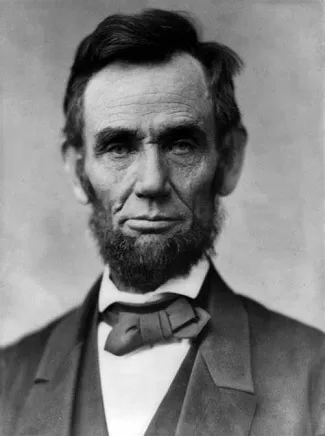
Abraham Lincoln
16. Abraham Lincoln - March 4, 1861 to March 4, 1865 / Vice Presidency Hannibal Hamlin 1860, Republican, Andrew Johnson, National Union, 1864
- Emancipation Proclamation: Lincoln issued the Emancipation Proclamation on January 1, 1863, declaring that all enslaved people in Confederate territory were to be forever free. While it did not immediately free all slaves, it shifted the war’s focus to include the abolition of slavery as a central goal.
- Preservation of the Union: Lincoln’s steadfast commitment to preserving the Union during the Civil War played a crucial role in keeping the United States intact and preventing the secession of Southern states.
- Gettysburg Address: Lincoln delivered the Gettysburg Address on November 19, 1863, honoring fallen Union soldiers and articulating the principles of democracy and equality that the nation was founded upon.
- Homestead Act of 1862: Lincoln signed the Homestead Act into law, providing free land to citizens willing to settle and develop the western territories, encouraging westward expansion.
- Transcontinental Railroad: Lincoln signed the Pacific Railway Act in 1862, which authorized the construction of the first transcontinental railroad, connecting the East and West coasts of the United States.
- National Banking System: Lincoln signed the National Banking Act in 1863, establishing a national banking system to stabilize the country’s financial system.
- Morrill Land-Grant Act: Lincoln signed the Morrill Land-Grant Act in 1862, providing federal land to states for the establishment of colleges focused on agricultural and mechanical education.
- Suspension of Habeas Corpus: While controversial, Lincoln’s suspension of habeas corpus during the Civil War allowed the government to detain individuals deemed threats to national security without trial.
- Passage of the Thirteenth Amendment: Lincoln’s advocacy and leadership played a pivotal role in the passage of the Thirteenth Amendment in 1865, permanently abolishing slavery in the United States.
- Re-election in 1864: Despite significant challenges during his first term, Lincoln’s re-election in 1864 demonstrated widespread support for his leadership and policies during the Civil War.
- Civil War: Lincoln’s presidency was dominated by the American Civil War, which posed immense challenges in preserving the Union and resolving the conflict between the North and South.
- High Casualties: The Civil War resulted in an enormous loss of life on both sides, with hundreds of thousands of soldiers and civilians killed or injured.
- Military Leadership: Lincoln faced difficulties in finding effective military leaders early in the war, leading to some military setbacks.
- Civil Liberties: The suspension of habeas corpus during the war raised concerns about civil liberties and led to arrests of individuals suspected of being Confederate sympathizers or sympathizers of the Southern cause.
- Copperheads and Political Opposition: Lincoln faced strong political opposition, particularly from Copperheads (anti-war Democrats) and others critical of his administration’s handling of the war.
- Emancipation and Resistance: While the Emancipation Proclamation in 1863 marked a significant step toward abolishing slavery, it faced resistance in some areas and did not immediately free all slaves.
- Economic Challenges: The war strained the nation’s economy, leading to inflation and financial difficulties for many Americans.
- Reconstruction Plans: Lincoln’s plans for Reconstruction were cut short by his assassination, leaving the task of rebuilding the South to his successor, Andrew Johnson.
- Public Pressure and Expectations: Lincoln faced enormous public pressure and expectations during the war, as many looked to him for leadership and decisive action.
- His Own Assassination: Lincoln’s assassination in April 1865 tragically cut short his efforts to reunify the country and fully implement Reconstruction policies.
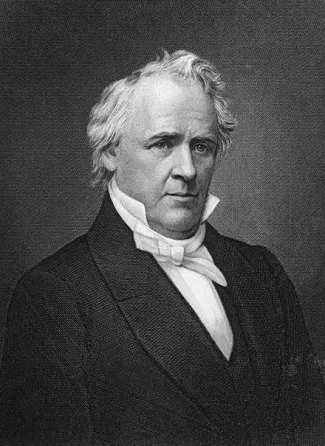
James Buchanan
15. Democratic - James Buchanan - March 4, 1857 to March 4, 1861 / John C. Breckinridge 1856
- Kansas-Nebraska Act: Buchanan supported the passage of the Kansas-Nebraska Act in 1854, which allowed for the expansion of slavery into new territories, further fueling sectional tensions.
- Avoiding War with Great Britain: Buchanan deftly handled the “Pig War” crisis between the United States and Great Britain over the San Juan Islands, successfully avoiding armed conflict.
- Gadsden Purchase: Buchanan’s administration negotiated the Gadsden Purchase in 1853, acquiring additional territory from Mexico to facilitate the construction of a southern transcontinental railroad.
- Promoting Trade: Buchanan pursued trade agreements and negotiated the Treaty of Reciprocity with Canada, aimed at enhancing trade relations with the neighboring country.
- Economic Growth: During Buchanan’s term, the United States experienced economic growth and prosperity, benefiting from industrialization and westward expansion.
- Minnesota Statehood: Buchanan signed the bill that admitted Minnesota as the 32nd state to the Union in 1858.
- Federal Land Grants: Buchanan signed legislation granting public lands to several states for the establishment of agricultural colleges, contributing to the advancement of education.
- Establishing the U.S. Camel Corps: While the initiative ultimately failed, Buchanan approved the establishment of the U.S. Camel Corps experiment, seeking to introduce camels as pack animals in the southwestern U.S.
- Support for a Transatlantic Cable: Buchanan advocated for the establishment of a transatlantic telegraph cable, facilitating communication between the United States and Europe.
- Early Preservation Efforts: Buchanan signed the Yosemite Grant Act in 1864, laying the groundwork for the preservation of Yosemite Valley and Mariposa Grove, an early step in America’s national park system.
- Bleeding Kansas: Buchanan struggled to handle the violent conflicts in the Kansas Territory between pro-slavery and anti-slavery factions, and his support for the pro-slavery Lecompton Constitution further divided the nation.
- Dred Scott Decision: The Supreme Court’s ruling in the Dred Scott case during Buchanan’s presidency declared that African Americans were not citizens and that Congress could not regulate slavery in the territories, intensifying sectional tensions.
- Buchanan’s Inaction: Buchanan’s reluctance to take decisive action to address the secession crisis and growing tensions between the North and South allowed the situation to escalate.
- Secession Crisis: Buchanan’s handling of the secession crisis in the Southern states, including his refusal to recognize the legality of secession, did little to prevent the eventual outbreak of the Civil War.
- Failure to Address Slavery: Buchanan did not take significant steps to address the issue of slavery, despite its central role in the growing sectional conflict.
- Political Divisions: Buchanan’s presidency was marked by significant political divisions, particularly within his own Democratic Party, further hindering effective governance.
- Economic Downturn: Buchanan’s administration faced economic challenges, including the Panic of 1857, which resulted in financial hardships for many Americans.
- Foreign Policy Challenges: Buchanan’s handling of foreign policy issues, such as the “Ostend Manifesto” and tensions with Britain over Central American affairs, faced criticism and controversy.
- Weak Leadership: Buchanan’s leadership during a critical time in the nation’s history was seen by many as ineffective and indecisive.
- Failure to Prevent Secession: Buchanan was unable to prevent the secession of Southern states and the formation of the Confederate States of America, which ultimately led to the Civil War.

Franklin Pierce
14. Democratic - Franklin Pierce - March 4, 1853 to March 4, 1857 / William R. King, vacant after April 18, 1853
- Gadsden Purchase: Pierce’s administration negotiated the Gadsden Purchase in 1853, acquiring land from Mexico to facilitate the construction of a southern transcontinental railroad.
- Ostend Manifesto: Pierce’s administration was involved in the Ostend Manifesto, a controversial attempt to acquire Cuba from Spain, which raised concerns about the expansion of slavery.
- Kansas-Nebraska Act: Pierce supported the passage of the Kansas-Nebraska Act in 1854, which allowed for the expansion of slavery into new territories and intensified sectional tensions.
- Treaty with Japan: Pierce’s administration negotiated the Treaty of Kanagawa in 1854, establishing trade and diplomatic relations with Japan after decades of isolation.
- Pacific Railroad Surveys: Pierce authorized several expeditions to survey potential routes for a transcontinental railroad, laying the groundwork for its eventual construction.
- Tariff Reduction: Pierce supported tariff reduction, signing the Tariff of 1857, which aimed to lower protective tariffs on imports.
- Treaty of Edo: Pierce’s administration finalized the Treaty of Edo with Japan in 1858, further expanding trade and diplomatic relations with the Asian nation.
- Nicaragua Canal Diplomacy: Pierce explored the possibility of building a canal across Nicaragua, seeking to establish a potential trade route between the Atlantic and Pacific Oceans.
- Early Preservation Efforts: Pierce signed the bill that created the San Francisco Mint and established the first federal wildlife reservation at Pelican Island, Florida, in 1857.
- Preserving the Union: Throughout his presidency, Pierce attempted to maintain unity and prevent the outbreak of Civil War, though his policies concerning slavery ultimately contributed to the nation’s growing divisions.
- Kansas-Nebraska Act (1854): One of the most significant failures of Pierce’s presidency was his support for the Kansas-Nebraska Act. This act allowed for popular sovereignty in determining the slavery status of new territories, effectively repealing the Missouri Compromise and intensifying tensions between pro-slavery and anti-slavery factions. This contributed to the outbreak of violence in “Bleeding Kansas.”
- Bleeding Kansas: The Kansas-Nebraska Act led to a rush of settlers, both pro-slavery and anti-slavery, to the Kansas Territory. This resulted in violent clashes between these factions, further deepening the divide between North and South over the expansion of slavery.
- Ostend Manifesto (1854): Pierce’s administration was involved in the Ostend Manifesto, a secret proposal to purchase Cuba from Spain. The manifesto’s content was leaked, causing outrage among anti-slavery activists who saw it as an attempt to extend slavery’s reach. The plan was eventually dropped due to public pressure.
- Gadsden Purchase (1853): While not inherently a failure, the Gadsden Purchase highlighted Pierce’s administration’s focus on expanding slavery. The purchase of land from Mexico for a southern transcontinental railroad route was seen by many as catering to Southern interests and strengthening the pro-slavery agenda.
- Failure to Address Sectional Tensions: Rather than calming sectional tensions, Pierce’s policies exacerbated them. His pro-Southern and pro-slavery positions alienated many Northerners, leading to a decline in his popularity and effectiveness.
- Dred Scott v. Sandford (1857): The Supreme Court’s decision in the Dred Scott case declared that African Americans, whether enslaved or free, could not be considered citizens and therefore had no standing to sue in federal courts. This decision further inflamed tensions and was seen as pro-slavery.
- Foreign Relations Challenges: Pierce’s administration struggled with foreign relations, including strained relations with Britain over territorial disputes in Central America (the “Clayton-Bulwer Treaty”) and issues involving American expansionism.
- Economic Challenges: The Pierce administration faced economic difficulties, including the Panic of 1857, a financial crisis that caused widespread unemployment and business failures. The administration’s response was criticized for its inability to effectively address the economic downturn.
- Loss of Party Support: Pierce’s pro-Southern and pro-slavery stance caused fractures within his own Democratic Party. Many Northern Democrats distanced themselves from his policies, further weakening his ability to govern effectively.
- Decline in Popularity: As a result of his perceived failures and divisive policies, Pierce’s popularity waned significantly during his presidency. He left office with low approval ratings and is often considered one of the least effective presidents in American history.
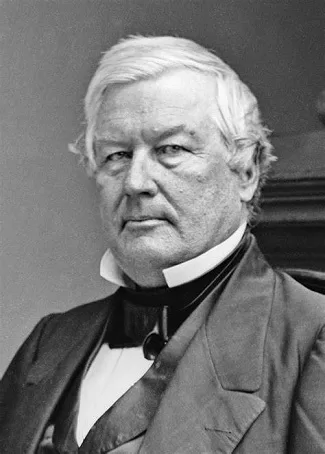
Milliard Fillmore
13. Whig - Millard Fillmore - July 9, 1850 to March 4, 1853 / Vacant through presidency
- Compromise of 1850: Fillmore played a key role in supporting and signing the Compromise of 1850, a series of measures aimed at addressing the contentious issues of slavery and territorial expansion. The compromise helped to temporarily ease tensions between the North and South.
- Fugitive Slave Act: As part of the Compromise of 1850, Fillmore also signed the Fugitive Slave Act, which required the return of escaped slaves to their owners, further aggravating the issue of slavery and intensifying opposition in the North.
- Opening Japan to the West: Fillmore’s administration negotiated the Treaty of Kanagawa in 1854, opening Japan to trade with the United States after centuries of isolation.
- California Statehood: Fillmore supported and signed the bill that admitted California as the 31st state to the Union in 1850.
- Land Grant Colleges: Fillmore signed the Land Grant College Act of 1850, also known as the Morrill Act, which provided federal land to states for the establishment of agricultural and mechanical colleges.
- Strengthening the Navy: Fillmore advocated for the strengthening of the U.S. Navy and worked to modernize its fleet during his term.
- Cuba and Filibustering: Fillmore’s administration had discussions with Spain about acquiring Cuba, but negotiations ultimately faltered. He also sought to suppress filibustering (unauthorized military expeditions) to Latin American countries.
- Reduction of National Debt: Under Fillmore’s presidency, efforts were made to reduce the national debt, reflecting his commitment to fiscal responsibility.
- Preservation of Union: Fillmore worked to maintain the unity of the country and uphold the Constitution during a time of growing sectional tensions.
- Washington, D.C., Development: Fillmore was involved in the development of Washington, D.C., contributing to the construction of various public buildings and improvements in the capital city.
- Compromise of 1850: Fillmore’s administration grappled with the passage and implementation of the Compromise of 1850, a series of legislative measures intended to address issues related to slavery and the admission of new states. While the compromise temporarily eased tensions, it did not resolve the underlying problems and ultimately contributed to the escalation of sectional strife.
- Fugitive Slave Act: Fillmore supported and signed the Fugitive Slave Act of 1850, which mandated the return of escaped slaves to their owners, further fueling opposition and resentment in Northern states.
- Slavery and Kansas-Nebraska Act: Fillmore’s handling of the Kansas-Nebraska Act, which allowed the territories of Kansas and Nebraska to decide on the issue of slavery through popular sovereignty, led to violence and political turmoil in “Bleeding Kansas.”
- Dred Scott Decision: Fillmore faced the repercussions of the Supreme Court’s Dred Scott decision, which expanded the reach of slavery into territories and heightened tensions between North and South.
- Sectional Divisions: Fillmore’s presidency was marked by growing sectional divisions over issues related to slavery and the expansion of slavery into new territories.
- Lack of Party Support: Fillmore was not nominated for re-election by his own party, the Whigs, indicating a lack of strong party support and unity during his presidency.
- Limited Domestic Policy Initiatives: Fillmore’s presidency lacked major domestic policy initiatives or reforms, resulting in a relatively unremarkable domestic legacy.
- Economic Downturn: Fillmore faced economic challenges, including the Panic of 1857, which caused financial hardship for many Americans.
- Foreign Policy Challenges: Fillmore’s handling of foreign policy issues, such as his opening of Japan to trade through the Treaty of Kanagawa, faced criticism and mixed reviews.
- Failure to Prevent the Civil War: Fillmore’s inability to address and defuse the underlying tensions between the North and South ultimately contributed to the outbreak of the Civil War during his successor’s presidency.
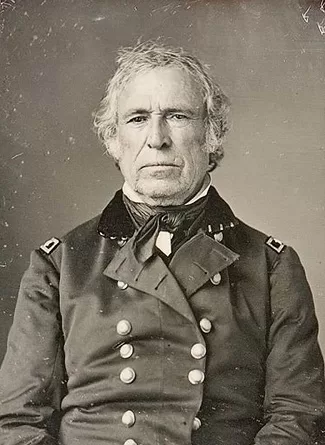
Zachary Taylor
12. Whig - Zachary Taylor - March 4, 1849 to July 9, 1850 / Millard Fillmore
- Victory in the Mexican-American War: Taylor’s success as a military general in the Mexican-American War (1846-1848) played a crucial role in securing victory for the United States and gaining significant territorial acquisitions, including California, New Mexico, and parts of Arizona, Utah, Colorado, and Nevada.
- Defending the Union: As a southern slaveholder, Taylor’s stance on the preservation of the Union and his military leadership helped to maintain the integrity of the nation during a time of growing sectional tensions.
- Avoiding a War with Great Britain: Taylor’s administration skillfully resolved the Aroostook War boundary dispute between Maine and New Brunswick, avoiding armed conflict with Great Britain.
- Admission of California to the Union: Taylor supported and encouraged California’s application for statehood, which was accomplished on September 9, 1850, as a free state.
- Opposing the Expansion of Slavery: Taylor’s opposition to the extension of slavery into the newly acquired territories influenced the growing debate over slavery’s expansion in the West.
- Prohibition of Slave Trade in the District of Columbia: Taylor advocated for a proposal that would have banned the slave trade in the District of Columbia, signaling his resistance to the expansion of slavery.
- Indian Affairs: Taylor’s administration addressed various issues relating to Native American tribes, particularly concerning land rights and negotiations.
- Supporting Internal Improvements: Taylor called for improvements in the country’s infrastructure, including the construction of roads and harbors, to foster economic development.
- Management of a Divided Cabinet: Taylor was skilled at managing a divided Cabinet, which included members with opposing views on slavery and territorial expansion.
- Establishment of a New Territory: Taylor supported the establishment of the Territory of Oregon, which occurred on August 14, 1848.
- Slavery and Sectional Tensions: Taylor’s presidency was marked by growing tensions over the issue of slavery and its expansion into new territories, particularly in the newly acquired territories from the Mexican-American War.
- California Statehood and Compromise of 1850: Taylor’s strong opposition to the proposed Compromise of 1850, which included the admission of California as a free state, exacerbated sectional divisions and complicated the path to a resolution.
- Southern Opposition: Taylor faced strong opposition from Southern states to his stance on slavery and his refusal to support the extension of slavery into new territories.
- Political Inexperience: Prior to becoming president, Taylor had no prior political experience or involvement, which made it challenging for him to navigate the complexities of Washington politics and build support for his policies.
- Native American Policy: Taylor’s administration encountered difficulties in its dealings with Native American tribes, particularly in regard to land rights and conflicts with Western tribes.
- Texas Border Dispute: The Texas border dispute with New Mexico further strained relations between the two territories and complicated efforts to address the sectional crisis.
- Economic Challenges: Taylor faced economic challenges, including the aftermath of the Panic of 1837, which contributed to financial hardships for many Americans.
- Relations with Congress: Taylor struggled to build a cooperative relationship with Congress, leading to difficulties in passing his policy agenda.
- Lack of Specific Policy Initiatives: Taylor’s presidency lacked clear and specific policy initiatives or a comprehensive agenda, making it difficult to address the nation’s pressing issues effectively.
- His Sudden Death: Taylor’s presidency was cut short by his untimely death in July 1850, just 16 months into his term. His death further complicated the resolution of the sectional crisis and necessitated the involvement of his successor, Millard Fillmore.
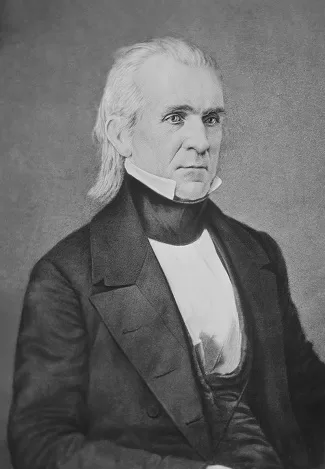
James K. Polk
11. Democratic - James K. Polk - March 4, 1845 to March 4, 1849 / George M. Dallas
- Acquisition of the Oregon Territory: Polk successfully negotiated with Great Britain to settle the long-standing dispute over the Oregon Territory, securing the region for the United States through the Oregon Treaty of 1846.
- Annexation of Texas: Polk’s administration oversaw the annexation of the Republic of Texas in 1845, making it the 28th state of the Union.
- Mexican-American War: Polk’s policies and actions led to the Mexican-American War (1846-1848), resulting in significant territorial gains for the United States, including present-day California, Nevada, Utah, Arizona, New Mexico, and parts of Colorado, Wyoming, and Texas.
- Treaty of Guadalupe Hidalgo: Polk’s administration negotiated the Treaty of Guadalupe Hidalgo in 1848, which officially ended the Mexican-American War and solidified the acquisition of vast territories from Mexico.
- Lowering Tariffs: Polk successfully advocated for lowering tariffs, signing the Walker Tariff of 1846, which aimed to reduce tariffs to promote trade and benefit consumers.
- Independent Treasury System: Polk signed the Independent Treasury Act of 1846, establishing an independent treasury system to handle federal funds, separate from private banks.
- Fiscal Responsibility: Polk’s administration practiced fiscal responsibility, maintaining balanced budgets and reducing government spending.
- California Gold Rush: Polk’s policies indirectly led to the discovery of gold in California in 1848, which triggered the California Gold Rush and contributed to the economic growth of the United States.
- Strengthening the Navy: Polk advocated for the strengthening of the U.S. Navy and expansion of naval facilities, enhancing America’s maritime capabilities.
- Expansion and Manifest Destiny: Under Polk’s leadership, the United States experienced significant territorial expansion, fulfilling the spirit of Manifest Destiny by adding substantial land to the country.
- Mexican-American War (1846-1848): Polk’s pursuit of territorial expansion led to the controversial Mexican-American War. While successful in acquiring vast territories including California, New Mexico, and parts of the Southwest, the war was criticized by anti-slavery advocates as a means to extend slave territory and led to debates about the morality of the conflict.
- Wilmot Proviso Controversy: During the Mexican-American War, the Wilmot Proviso was proposed, which sought to ban slavery in any territory acquired from Mexico. The debate over the proviso heightened sectional tensions and highlighted the North-South divide on the issue of slavery.
- Oregon Territory Dispute: The Polk administration’s stance on the Oregon Territory border with Britain led to the famous slogan “54°40′ or Fight,” referring to the desired northern border of the territory. The compromise settlement at the 49th parallel avoided war but disappointed some expansionists.
- Internal Division in the Democratic Party: Polk’s presidency saw divisions within the Democratic Party over issues like territorial expansion and the spread of slavery. This division would have long-lasting effects on the party’s cohesion and ability to effectively govern.
- Failure to Annex Texas Smoothly: While Polk achieved the annexation of Texas, the process was marked by difficulties, including opposition from anti-slavery forces, concerns over potential conflicts with Mexico, and the challenges of incorporating a new state into the Union.
- Failure to Secure California Peacefully: Despite Polk’s initial intent to acquire California through peaceful means, the administration’s handling of negotiations with Mexico and its military actions led to the use of force and ultimately contributed to the outbreak of the Mexican-American War.
- Economic Challenges and Tariff Policies: The Polk administration faced economic difficulties, including revenue shortfalls and a general economic downturn. His administration’s policies, including the Walker Tariff, didn’t effectively address these economic challenges.
- Treaty of Guadalupe Hidalgo Shortcomings: While the Treaty of Guadalupe Hidalgo ended the Mexican-American War and secured significant territorial gains for the United States, some criticized Polk’s negotiation for not achieving all the territorial ambitions that some expansionists had hoped for.
- Rising Tensions over Slavery Expansion: Polk’s presidency saw the intensification of debates over the expansion of slavery, as new territories were acquired. This further fueled the growing divide between North and South on the issue of slavery.
- Health and Exhaustion: Polk’s aggressive pursuit of his policy agenda, including territorial expansion and manifest destiny goals, took a toll on his health. He only served one term as president and declined to seek re-election due to his exhaustion and declining health.
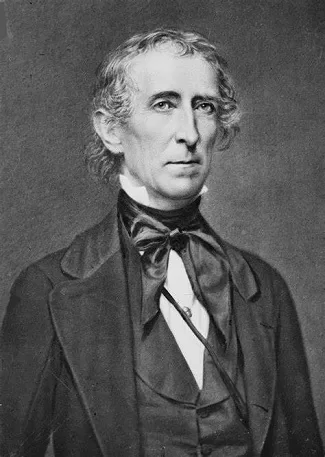
John Tyler
10. Unaffiliated - John Tyler - April 4, 1841 to March 4, 1845 / Vacant throughout presidency
- Annexation of Texas: Tyler’s administration initiated negotiations with Texas, culminating in the passage of a joint resolution in Congress that led to the annexation of Texas to the United States in 1845.
- Florida Statehood: Tyler signed the bill that admitted Florida as the 27th state to the Union in 1845.
- Webster-Ashburton Treaty: Tyler’s administration successfully negotiated the Webster-Ashburton Treaty with Great Britain in 1842, settling various boundary disputes between the United States and British
North America (Canada). - Tariff Reduction: Tyler supported and signed the Tariff Act of 1842, which aimed to reduce tariff rates to promote trade and benefit consumers.
- Independent Treasury System: Tyler signed the Independent Treasury Act
of 1840, establishing an independent treasury system to handle federal
funds, separate from private banks. - Native American Policy: Tyler pursued a policy of Indian removal,
leading to the signing of several treaties with Native American tribes. - Veto of Banking Legislation:
Tyler exercised his veto power to reject the re-chartering of the Second Bank of the United States in 1841, leading to its eventual demise. - Opposition to Internal Improvements:
Tyler consistently opposed federally funded internal improvements, believing them to be unconstitutional and favoring states’ rights on such matters. - River and Harbor Improvements:
While opposing internal improvements funded by the federal government, Tyler did support some river and harbor improvement projects, particularly in his home state of Virginia. - Naval Expansion: Tyler advocated for the expansion of the U.S. Navy, with a focus on modernizing its fleet and strengthening maritime capabilities.
- Succession Crisis: Tyler’s ascension to the presidency after the death of President William Henry Harrison in 1841 created a constitutional crisis, as there was no clear precedent for the succession of a vice president to the presidency.
- Party Alienation: Tyler’s presidency was marked by his expulsion from the Whig Party due to disagreements over policy matters, leaving him without a strong political base of support.
- Veto of the Bank Bill: Tyler’s veto of the rechartering of the Bank of the United States in 1841 further alienated him from his party and contributed to a deepening divide with Congress.
- Opposition to Tariffs: Tyler opposed high protective tariffs favored by many of his fellow Whigs, leading to disagreements within the party and making it challenging to pass tariff legislation.
- Annexation of Texas: While Tyler succeeded in achieving the annexation of Texas, it was a divisive issue that further intensified sectional tensions over the expansion of slavery.
- Failed Treaty of Annexation: An earlier attempt to annex Texas through a treaty was rejected by the Senate, representing a diplomatic setback for Tyler’s administration.
- State Department Controversy: A scandal involving the State Department and accusations of financial irregularities tainted Tyler’s administration.
- Economic Challenges: Tyler’s presidency faced economic difficulties, including the Panic of 1837, which persisted into the early years of his term.
- Foreign Policy Difficulties: Tyler’s foreign policy faced challenges, including tensions with Great Britain over the border with Canada and disputes with Mexico.
- Limited Impact on Legislation: Tyler’s strained relationship with Congress and the lack of a strong political coalition hampered his ability to pass significant legislative initiatives.
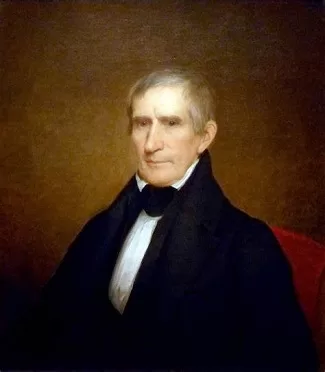
William Henry Harrison
9. Whig - William Henry Harrison - March 4, 1841 to April 4, 1841 / John Tyler
- Shortest Presidency: Harrison’s presidency holds the record for being the shortest in U.S. history, with only 31 days in office.
- Inaugural Address: Harrison delivered the longest inaugural address in U.S. history, lasting nearly two hours, on a cold and rainy day. This might have contributed to his subsequent illness.
- Whig Party’s First President: Harrison was the first president from the Whig Party, representing the party’s victory in the 1840 election.
- Popularity and the “Log Cabin Campaign”: Harrison’s campaign adopted a populist image, emphasizing his humble beginnings in a log cabin, which resonated with voters and contributed to his electoral success.
- Economic Focus: Harrison intended to focus on economic issues during his presidency, including the promotion of industry and economic development.
- National Bank Advocacy: Harrison supported the idea of reestablishing a national bank, similar to the one that Andrew Jackson had abolished during his presidency.
- Limited Policy Implementation: Due to his brief time in office, Harrison did not have the opportunity to implement most of his proposed policies or initiatives.
- Death and Succession: Harrison’s death from pneumonia on April 4, 1841, led to Vice President John Tyler assuming the presidency, setting a precedent for presidential succession.
- Infrastructure Advocacy: Harrison promoted the need for improvements to the nation’s infrastructure, including roads and canals.
- Legacy of Tragedy: Harrison’s presidency is often remembered for the tragedy of his untimely death, which made him the first U.S. president to die in office.
- Inaugural Address: Harrison delivered the longest inaugural address in U.S. history, lasting nearly two hours, on a cold and rainy day. This decision negatively impacted his health, ultimately leading to his death from pneumonia just a month into his presidency.
- Lack of Clear Agenda: Harrison’s administration lacked a clear and well-defined agenda. This made it difficult for him to communicate his policy priorities effectively to both Congress and the public.
- Cabinet Appointments: Harrison’s choices for his cabinet were seen as politically motivated rather than based on merit. This led to internal conflicts and a lack of cohesion within the administration.
- Struggle with Congress: Harrison faced challenges in working with Congress to pass legislation. He did not have strong political alliances, and his inexperience in navigating the complexities of legislative negotiations hindered his ability to push through his agenda.
- Economic Recession: During Harrison’s presidency, the United States was grappling with an economic recession. He was unable to address the economic issues effectively during his short time in office.
- Native American Relations: Harrison’s administration did not handle Native American relations well. He advocated for the removal of Native American tribes from their ancestral lands, which contributed to tensions and conflicts.
- Inadequate Response to Naval Threats: The British continued to impress American sailors and interfere with American trade at sea. Harrison’s administration struggled to respond effectively to these challenges, which strained relations with Britain.
- Limited Foreign Policy Achievements: Harrison’s foreign policy efforts were limited and lacked significant achievements. He was unable to make significant progress in international relations during his short tenure.
- Communication Challenges: Harrison’s administration faced challenges in effectively communicating its policies and intentions to the public. This lack of clear communication contributed to misunderstandings and public dissatisfaction.
- Unfulfilled Promises: Harrison’s campaign had promised various reforms and changes, but he was unable to deliver on most of these promises due to his short time in office and the challenges his administration faced.
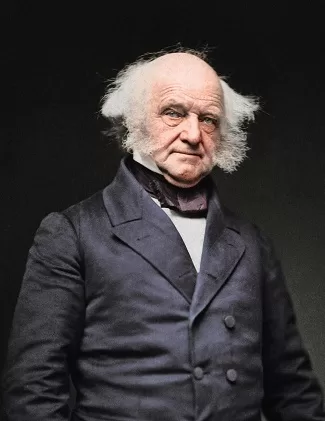
Martin Van Buren
8. Democratic - Martin Van Buren - March 4, 1837 to March 4, 1841 / Richard Mentor Johnson
- Establishing an Independent Treasury System: Van Buren signed the Independent Treasury Act in 1840, which established an independent treasury system to handle federal funds, separate from private banks.
- Avoiding War with Britain: Van Buren’s administration successfully negotiated a settlement with Great Britain over the Caroline Affair, diffusing tensions and avoiding war.
- Peaceful Resolution of the Aroostook War: Van Buren’s administration helped negotiate the Webster-Ashburton Treaty in 1842, resolving the Aroostook War boundary dispute between Maine and Canada (British North America).
- Reducing the National Debt: Van Buren’s administration continued the policies of his predecessor, Andrew Jackson, and successfully reduced the national debt.
- Supporting Free Trade: Van Buren supported the principles of free trade and opposed high protective tariffs.
- Indian Removal Policy: While controversial, Van Buren continued to implement the Indian Removal Policy, leading to the forced removal of Native American tribes from their ancestral lands in the southeastern United States.
- Defending the Amistad Africans: Van Buren’s administration played a role in the legal proceedings concerning the Amistad Africans, who were captured as slaves but eventually won their freedom in court.
- Strengthening the Navy: Van Buren advocated for the strengthening of the U.S. Navy and supported naval modernization efforts.
- Precedence for Peaceful Transfer of Power: Van Buren’s peaceful transfer of power to his successor, William Henry Harrison, set an essential precedent for American democracy.
- Opposition to the Expansion of Slavery: While Van Buren was a slaveholder, he opposed the expansion of slavery into new territories and supported the principles of the Free Soil movement.
- Economic Depression (Panic of 1837): Van Buren’s presidency was marked by a severe economic depression that began shortly after he took office. The Panic of 1837 led to widespread bank failures, unemployment, and suffering for many Americans. Van Buren struggled to effectively address the economic crisis, and his policies were criticized for being inadequate.
- Unpopular Fiscal Policies: Van Buren’s response to the economic depression included his decision not to establish a new national bank and his advocacy for the “Divorce Bill,” which aimed to separate the federal government from banking. These policies were unpopular and contributed to economic instability.
- Lack of Leadership During the Panic: Many Americans perceived Van Buren as being detached and ineffective in addressing the economic hardships caused by the Panic of 1837. His inability to alleviate the suffering of ordinary citizens eroded his popularity.
- Partisan Divisions: Van Buren faced deepening partisan divisions during his presidency, particularly over issues related to the economic crisis and slavery. His inability to bridge these divides contributed to political gridlock and hindered his policy agenda.
- Amistad Incident: The Amistad incident involved a group of African captives who revolted against their Spanish captors aboard the Amistad ship. Van Buren’s administration struggled to handle the legal and diplomatic complexities of the case, and the resolution was seen as a failure to take a clear stance on the issue of slavery.
- Inadequate Foreign Policy Response: Van Buren’s handling of foreign policy challenges, such as the Canadian border dispute with Britain and tensions with Mexico over the annexation of Texas, was criticized for lacking a strong and effective approach.
- Limited Solutions for the Unemployed: During the economic depression, Van Buren’s administration had limited tools to address the widespread unemployment and poverty. His attempts to create government jobs through public works projects were met with mixed success.
- Failed Re-Election Campaign: Van Buren’s bid for re-election in 1840 was unsuccessful. He faced criticism for his handling of the economic crisis and his inability to alleviate the hardships faced by the American people.
- Resistance to Abolitionist Movement: Van Buren’s administration was criticized for its lack of support for the abolitionist movement. He prioritized maintaining party unity and political stability over taking a strong stance against slavery.
- Failure to Secure Texas Annexation: Van Buren’s administration did not succeed in annexing the Republic of Texas into the United States. This failure had long-term implications for U.S. expansion and relations with Mexico.
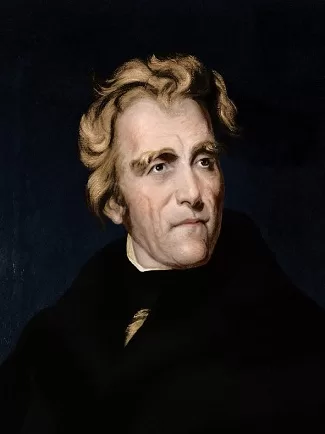
Andrew Jackson
7. Democratic - Andrew Jackson - March 4, 1829 to March 4, 1837 / 1828 John C. Calhoun, 1832 Martin Van Buren, vacant after December 28, 1832
- Indian Removal Act: One of the most controversial aspects of Jackson’s presidency was the passage and enforcement of the Indian Removal Act in 1830. The act led to the forced removal of Native American tribes, such as the Cherokee, from their ancestral lands in the southeastern United States, resulting in the tragic Trail of Tears.
- Nullification Crisis: Jackson’s firm response to the Nullification Crisis in 1832-1833, wherein South Carolina attempted to nullify federal tariffs, demonstrated his commitment to preserving the Union and enforcing federal authority.
- Bank War: Jackson’s opposition to the Second Bank of the United States culminated in his veto of the bank’s rechartering in 1832 and the subsequent withdrawal of federal funds from the bank, effectively killing it. This action solidified his reputation as a champion of states’ rights and an opponent of concentrated financial power.
- Expansion of Executive Power: Jackson’s presidency was marked by a significant expansion of executive power, and he is often considered one of the most assertive and influential presidents in shaping the modern presidency.
- Reducing National Debt: Jackson’s administration successfully reduced the national debt, aiming to create a more financially stable and economically independent nation.
- Land Policies and Westward Expansion: Jackson’s administration supported policies that accelerated westward expansion, including the Indian Removal Act, which opened up vast territories for white settlement.
- Spoils System: Jackson’s use of the spoils system, the practice of appointing political supporters to government positions, became a hallmark of his presidency.
- Kitchen Cabinet: Jackson relied heavily on a group of informal advisors, often referred to as the “Kitchen Cabinet,” rather than his official cabinet, to help shape policy decisions.
- Securing Florida: Jackson’s successful military actions in Florida during the First Seminole War contributed to the United States’ acquisition of the territory from Spain in the Adams-Onís Treaty of 1819.
- Strengthening the Military: Jackson’s administration focused on strengthening the U.S. military, modernizing its forces, and expanding its capabilities.
- Indian Removal Policy: One of the most notorious failures of Jackson’s administration was the forced removal of Native American tribes from their ancestral lands, known as the Trail of Tears. Thousands of Native Americans died as a result of exposure, disease, and harsh conditions during their forced relocation to the west.
- Nullification Crisis: Jackson faced a major constitutional crisis when South Carolina attempted to nullify the federal tariffs imposed on imported goods. Jackson firmly opposed this challenge to federal authority and threatened to use military force to enforce federal law.
- Bank War and Economic Policies: Jackson’s opposition to the Second Bank of the United States led to the Bank War. He vetoed the bank’s recharter, which contributed to financial instability and a series of speculative bubbles, culminating in the Panic of 1837.
- Panic of 1837: The economic downturn during Jackson’s second term, known as the Panic of 1837, resulted in widespread bank failures, business closures, and high unemployment. His economic policies and banking practices were criticized for exacerbating the crisis.
- Crisis in South Carolina: The Nullification Crisis escalated tensions between the federal government and South Carolina, which claimed the right to nullify federal laws it considered unconstitutional. Jackson’s response was forceful, raising concerns about states’ rights and the power of the federal government.
- Conflict with Native American Tribes: Beyond the Indian Removal Policy, Jackson’s administration was marked by numerous conflicts with various Native American tribes, leading to violence, displacement, and loss of life.
- Spoils System: Jackson’s extensive use of the spoils system, which involved replacing government officials with his supporters, led to charges of cronyism and corruption within his administration.
- Foreign Relations and Texas Annexation: Jackson’s attempts to annex Texas were met with resistance from Mexico, leading to tensions and contributing to the later conflict between the United States and Mexico.
- Supreme Court Relations: Jackson famously clashed with the Supreme Court over the case of Worcester v. Georgia, where the Court ruled in favor of the Cherokee Nation’s sovereignty. Jackson reportedly disregarded the ruling, leading to concerns about executive overreach.
- Tensions with Congress: Jackson’s strong-willed and confrontational approach often strained his relationship with Congress. His use of the veto power and his assertion of executive authority were seen as challenges to the balance of power between branches of government.
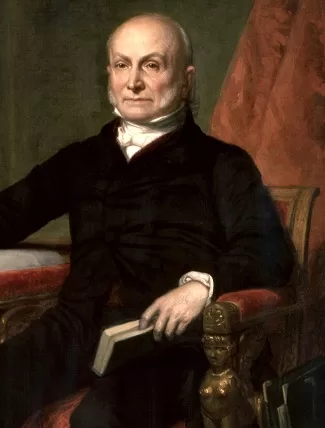
John Quincy Adams
6. Democratic-Republican - John Quincy Adams - March 4, 1825 to March 4, 1829 / 1824 John C. Calhoun
- Florida Acquisition: Adams’s administration successfully negotiated the Adams-Onís Treaty of 1819, which secured the acquisition of Florida from Spain, resolving territorial disputes.
- Promoting Internal Improvements: Adams advocated for federal funding for internal improvements, such as roads, canals, and bridges, to support economic development and national unity.
- Tariff of 1828: Adams supported and signed the Tariff of 1828, also known as the “Tariff of Abominations,” which aimed to protect American industry but caused controversy in the South due to its perceived negative impact on agriculture.
- Advocacy for National University: Adams advocated for the establishment of a national university and a national astronomical observatory to promote education and scientific research.
- Boundary Treaties: Adams’s administration successfully negotiated several boundary treaties, including the Treaty of 1827 with the United Kingdom, which clarified the border between the United States and Canada.
- Support for American Literature and the Arts: As a strong advocate of culture and education, Adams supported initiatives to promote American literature, science, and the arts.
- Founding of the Smithsonian Institution: Adams played a pivotal role in establishing the Smithsonian Institution in 1846, an institution dedicated to the advancement of knowledge through research and education.
- Naval Expansion: Adams supported the expansion and modernization of the U.S. Navy, enhancing America’s maritime capabilities.
- Treaty of 1825 with Russia: Adams’s administration negotiated a treaty with Russia, which fixed the southern boundary of Alaska along the 54°40’N latitude.
- Early Opposition to Slavery: Adams’s presidency laid the groundwork for his later career as an anti-slavery advocate when he began to speak out against the “gag rule” in Congress, which prevented discussions on slavery petitions.
- Controversial Election of 1824: Adams’s presidency began with controversy due to the disputed election of 1824. He won the presidency through a contingent election in the House of Representatives, even though Andrew Jackson had won the popular vote and more electoral votes.
- Lack of Popular Mandate: Because of the circumstances of his election, Adams struggled with a perceived lack of popular mandate, which hindered his ability to enact his policy agenda and generated political opposition.
- Political Polarization: Adams faced political polarization during his presidency, with supporters of Andrew Jackson forming a strong opposition. This polarization made it challenging for him to build coalitions to pass legislation.
- Failed Domestic Agenda: Adams had ambitious domestic policies, including plans for internal improvements and a national university. However, many of his proposals faced resistance in Congress, and he struggled to gain support for his initiatives.
- Tariff of Abominations: The Tariff of 1828, which raised tariffs on imported goods, was highly unpopular in the South, as it hurt their agricultural economy and increased the cost of manufactured goods. This contributed to sectional tensions.
- Failure to Address Slavery: Adams faced criticism for not taking a more active stance against slavery and not using his presidency to promote anti-slavery policies or address the issue of expanding slavery into new territories.
- Limited Foreign Policy Achievements: While Adams had a strong background in foreign affairs, his presidency saw limited successes in international relations. His efforts to improve diplomatic relations with Britain were met with mixed results.
- Ineffectual Patronage System: Adams’s administration struggled with patronage and appointments, often facing criticism for not adhering to the spoils system that was becoming more prevalent in American politics.
- Public Perception and Communication Challenges: Adams had difficulty connecting with the American public and communicating his policies effectively. His intellectual and reserved demeanor sometimes made him appear distant and unrelatable to ordinary citizens.
- Limited Popular Support for Re-Election: Adams’s bid for re-election in 1828 was unsuccessful, as he faced a strong challenge from Andrew Jackson, who enjoyed broad popular support. The election underscored his lack of popularity and widespread dissatisfaction with his administration.

James Monroe
5. Democratic-Republican - James Monroe - March 4, 1817 to March 4, 1825 / 1816, 1820 Daniel D. Tompkins
- Monroe Doctrine: One of the most important accomplishments of Monroe’s presidency was the formulation and enunciation of the Monroe Doctrine in 1823. This policy asserted that the Western Hemisphere was to be closed to further colonization by European powers and that any attempts to interfere in the affairs of independent American nations would be seen as hostile acts.
- Era of Good Feelings: Monroe’s presidency is associated with a period of relative political harmony and economic growth in the United States, known as the Era of Good Feelings.
- Missouri Compromise: Monroe played a behind-the-scenes role in the Missouri Compromise of 1820, which temporarily resolved the issue of slavery’s expansion by admitting Missouri as a slave state and Maine as a free state, while prohibiting slavery in the rest of the Louisiana Purchase territory north of the 36°30′ parallel.
- Florida Acquisition: Monroe’s administration successfully negotiated the Adams-Onís Treaty of 1819, securing the acquisition of Florida from Spain and resolving territorial disputes.
- Purchase of Florida’s Territorial Claims: Prior to the Adams-Onís Treaty, Monroe’s administration reached an agreement with Spain to purchase Florida’s territorial claims for $5 million.
- Infrastructure Projects: Monroe advocated for and supported internal improvements, such as the construction of roads and canals, to promote economic development and national unity.
- Second Bank of the United States: Monroe signed legislation rechartering the Second Bank of the United States in 1816, providing stability to the nation’s financial system.
- Westward Expansion: Monroe’s administration supported westward expansion and the settlement of new territories, including encouraging the migration of Americans to lands west of the Appalachian Mountains.
- Treaty of 1818: Monroe’s administration negotiated the Treaty of 1818 with Great Britain, which established the U.S.-Canada border along the 49th parallel from the Lake of the Woods to the Rocky Mountains, and provided joint occupation of the Oregon Country with Britain.
- Foreign Relations: Monroe’s presidency saw a focus on diplomatic efforts and peaceful relations with foreign nations, seeking to avoid unnecessary conflicts and promote American interests abroad.
- Economic Issues and the Panic of 1819: Monroe’s presidency was marked by economic difficulties, including the Panic of 1819, which was the first major financial crisis in the United States. It led to bank failures, unemployment, and a severe economic depression.
- Slavery and the Missouri Compromise: Monroe faced the contentious issue of slavery expansion into new territories. The Missouri Compromise of 1820 attempted to address this by maintaining a balance between slave and free states, but it only temporarily delayed the inevitable conflicts over slavery.
- Foreign Relations with Spain and Florida: The United States faced challenges in its relations with Spain over the acquisition of Florida. Monroe’s administration had to deal with border disputes, raids by Seminole Indians, and strained diplomatic negotiations.
- Missouri Crisis and Sectionalism: The Missouri Compromise exposed the growing sectionalism between the North and the South. While it temporarily preserved the balance between slave and free states, it also highlighted the deep divide over the issue of slavery.
- Infrastructure Challenges: Monroe’s administration faced difficulties in funding and implementing infrastructure projects, such as roads and canals. The internal improvements debate highlighted the tension between federal and state responsibilities.
- Rise of Political Factions: Despite the “Era of Good Feelings” label, political factions and disagreements were present. The emergence of new political parties, such as the Democratic-Republicans and the beginnings of the Whig Party, demonstrated growing divides.
- Limited Progress on Foreign Policy: While Monroe Doctrine, issued in 1823, aimed to limit European intervention in the Americas, Monroe’s administration struggled to enforce its provisions effectively. The doctrine’s full impact would be realized in later years.
- Challenges with Native American Relations: Monroe faced ongoing challenges in dealing with Native American tribes and their dispossession from ancestral lands, often due to pressure from white settlers and state governments.
- Infrastructure Funding and Economic Philosophy: The administration faced debates over the federal government’s role in funding internal improvements and its broader economic philosophy. Differences in opinion between those who supported government intervention and those who advocated for limited government intervention led to policy challenges.
- Transition of Florida to U.S. Territory: The acquisition of Florida from Spain presented administrative challenges in governing and integrating the new territory into the United States, including addressing border issues and interactions with Native American tribes.
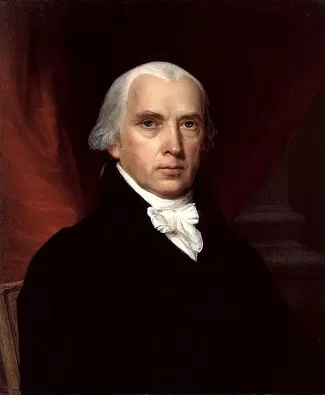
James Madison
4. Democratic-Republican - James Madison - March 4, 1809 to March 4, 1817 / 1808 George Clinton, vacant after April 20, 1812, 1812 Elbridge Gerry, vacant after November 23, 1814
- Leading during the War of 1812: Madison’s leadership during the War of 1812, sometimes referred to as the “Second War for Independence,” demonstrated his commitment to defending American sovereignty and national interests against British aggression.
- Successful Military Campaigns: Madison’s administration saw successful military campaigns, including Andrew Jackson’s victory at the Battle of New Orleans in 1815, which boosted American morale and secured an important victory at the end of the war.
- Treaty of Ghent: Madison’s administration successfully negotiated the Treaty of Ghent in 1814, which ended the War of 1812 and restored the pre-war status quo between the United States and Great Britain.
- Expansion of the United States: Madison’s presidency oversaw the acquisition of significant territory through the Louisiana Purchase in 1803, which doubled the size of the nation.
- Internal Improvements: Madison advocated for internal improvements, including roads and canals, to promote economic development and strengthen national unity.
- Renewal of the National Bank: Madison signed legislation renewing the charter of the Second Bank of the United States in 1816, providing stability to the nation’s financial system.
- Protective Tariffs: Madison supported and signed the Tariff of 1816, the first protective tariff in U.S. history, to protect American industries from foreign competition.
- Promoting Education: Madison advocated for the establishment of the Second Bank of the United States, which included provisions to fund the expansion of education and scientific research.
- Expansion of the Navy: Madison’s administration focused on the expansion and modernization of the U.S. Navy, enhancing America’s maritime capabilities.
- Avoiding Involvement in European Wars: Madison sought to maintain a policy of neutrality and avoid entanglement in European conflicts during his presidency.
- War of 1812: One of the most significant challenges of Madison’s presidency was the War of 1812 with Britain. The war was marked by military setbacks, including the burning of Washington, D.C., and failures in initial military planning.
- Lack of Preparedness: The United States was ill-prepared for the War of 1812, with a small and underfunded military. This lack of preparation contributed to early defeats and difficulties in conducting the war.
- Ineffective Military Leadership: Madison faced challenges in appointing effective military leaders and coordinating successful strategies. The military leadership during the war was often criticized for its failures.
- British Blockade and Trade Disruptions: British naval blockades during the War of 1812 disrupted American trade and led to economic hardships, particularly for coastal and maritime communities.
- Failed Invasion of Canada: The U.S. attempted to invade Canada as part of the war effort, but the efforts were unsuccessful and met with resistance from both the British and Canadian forces.
- Hartford Convention: During Madison’s presidency, the Federalist Party held the Hartford Convention in 1814, where they discussed their grievances and contemplated secession. Though it didn’t have a direct impact, it highlighted divisions and discontent.
- Economic Struggles: The disruption of trade, the war’s expenses, and the subsequent economic depression (the “Panic of 1819”) posed challenges to Madison’s administration and the broader American economy.
- Native American Relations: Madison’s administration faced conflicts with Native American tribes in the Western territories, and the war with Britain complicated matters further, as some tribes sided with the British.
- Ineffective Defense of Washington, D.C.: The British invasion of Washington, D.C., in 1814 resulted in the burning of important government buildings, including the White House and the Capitol, exposing weaknesses in the nation’s defenses.
- Limited Military Successes: While the war eventually ended in 1815 with the signing of the Treaty of Ghent, the U.S. achieved few clear military successes during the conflict, and many of the war’s objectives were not fully realized.
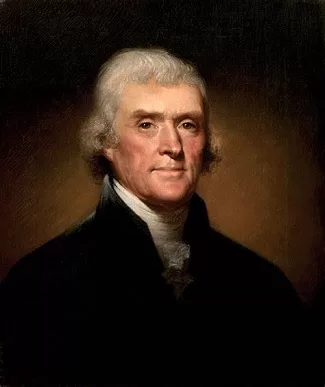
Thomas Jefferson
3. Democratic-Republican - Thomas Jefferson - March 4, 1801 to March 4, 1809 / 1800 Aaron Burr, 1804 George Clinton
- Louisiana Purchase: One of the most significant accomplishments of Jefferson’s presidency was the negotiation and purchase of the vast Louisiana Territory from France in 1803, doubling the size of the United States and opening up new lands for westward expansion.
- Lewis and Clark Expedition: Jefferson commissioned the famous Lewis and Clark Expedition in 1804, led by Meriwether Lewis and William Clark, to explore and map the newly acquired Louisiana Territory, as well as find a practical route to the Pacific Ocean.
- Embargo Act of 1807: In response to maritime conflicts and to protect American neutrality, Jefferson signed the Embargo Act of 1807, prohibiting American ships from trading with foreign nations. Though it had negative economic effects, it was an effort to avoid war and protect American interests.
- Repeal of the Alien and Sedition Acts: Jefferson and his Democratic-Republican Party successfully repealed the Alien and Sedition Acts, which were seen as unconstitutional and infringements on civil liberties.
- Reducing the National Debt: Jefferson prioritized fiscal responsibility and reduced the national debt during his presidency.
- Reduction of Military Spending: Jefferson scaled back the size of the U.S. military, reflecting his preference for a smaller standing army and a reliance on state militias for defense.
- Religious Freedom: Jefferson championed religious freedom and separation of church and state, a belief reflected in the Virginia Statute for Religious Freedom and his views on the First Amendment.
- Expansion of Public Education: Jefferson advocated for the establishment of public education and supported the creation of a system of public schools in Virginia.
- Non-Intervention in European Conflicts: Jefferson sought to avoid entanglement in European conflicts and maintained a policy of neutrality during the Napoleonic Wars.
- Midnight Judges: Before the end of his presidency, Jefferson’s administration successfully repealed the Judiciary Act of 1801, resulting in the removal of the so-called “Midnight Judges” appointed by John Adams at the end of his term.
- Embargo Act of 1807: One of the most significant failures of Jefferson’s presidency was the Embargo Act of 1807. Intended to protect American interests by prohibiting trade with foreign nations, the act ended up severely damaging the American economy and causing widespread hardship among merchants and farmers.
- Challenges with the Barbary Pirates: Jefferson inherited ongoing conflicts with the Barbary States of North Africa, which engaged in piracy and demanded tribute from American ships. Despite military actions, achieving a lasting resolution proved difficult during his presidency.
- Marbury v. Madison: The landmark Supreme Court case Marbury v. Madison (1803) established the principle of judicial review, where the court could declare laws unconstitutional. This decision underscored tensions between the executive and judicial branches and limited some of Jefferson’s authority.
- Louisiana Purchase Challenges: While the Louisiana Purchase significantly expanded American territory, it presented challenges in terms of governance, administration, and relations with Native American tribes already residing in the region.
- Continued Native American Conflicts: Jefferson faced ongoing difficulties with Native American tribes resisting westward expansion. The administration’s policies often failed to provide a peaceful resolution to conflicts, leading to tensions and violence.
- Conflict in Ohio Valley and Western Territories: The administration’s handling of conflicts in the Ohio Valley and the western territories highlighted the complexities of maintaining peace with Native American tribes while accommodating settlers’ demands for land.
- Restrictions on International Trade: Jefferson’s policy of embargo and non-intercourse with European powers, intended to protect American neutrality, caused economic hardships and strained relationships with trading partners.
- Challenges with the Judiciary: The “midnight appointments” by Adams before leaving office led to tensions between Jefferson and the Federalist-leaning judiciary, as he sought to limit their influence and power.
- Battle over the Repeal of the Judiciary Act: Jefferson’s attempt to repeal the Judiciary Act of 1801 and eliminate several federal court positions encountered resistance in Congress and illustrated the difficulty of making changes to established institutions.
- Failure to Fully End the Slave Trade: While Jefferson expressed concerns about the international slave trade, his efforts to abolish it faced opposition from Southern states and those with vested economic interests in the practice.
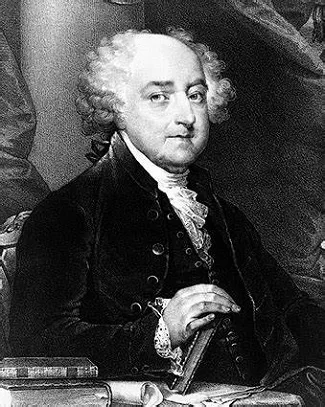
John Adams
2. Federalist - John Adams - March 4, 1797 to March 4, 1801 / 1796 Thomas Jefferson
- Avoiding War with France: Adams’s administration successfully negotiated the Treaty of Mortefontaine in 1800, which ended the Quasi-War with France and prevented an all-out conflict.
- Peaceful Transition of Power: Adams’s presidency demonstrated the successful transition of power from one political party to another, establishing the precedent for the peaceful transfer of power in American democracy.
- Alien and Sedition Acts: While controversial, Adams’s administration passed the Alien and Sedition Acts in 1798, aimed at addressing perceived threats to national security and restricting criticism of the government.
- Expansion of the U.S. Navy: Adams advocated for the expansion and modernization of the U.S. Navy, enhancing America’s maritime capabilities.
- Establishment of the Department of the Navy: Adams’s administration played a role in the creation of the Department of the Navy in 1798, which further strengthened the nation’s naval forces.
- Appointment of John Marshall as Chief Justice: Adams appointed John Marshall as Chief Justice of the Supreme Court, solidifying the judiciary’s role in shaping the interpretation of the Constitution.
- Avoiding War with France: Adams’s administration sought to avoid escalation into a full-blown war with France during the Quasi-War, despite increasing tensions.
- Strengthening Diplomatic Ties: Adams worked to strengthen diplomatic ties with other nations, promoting peace and commerce.
- Midnight Judges: Before the end of his presidency, Adams’s administration appointed several federal judges, known as the “Midnight Judges,” to fill vacancies in the judiciary.
- National Defense: Adams prioritized national defense and military preparedness during his presidency, in response to the geopolitical challenges of the time.
- Quasi-War with France: Tensions escalated between the United States and France during Adams’s presidency, leading to an undeclared naval conflict known as the Quasi-War. This strained relations with a former ally and posed challenges for Adams in maintaining peace while also protecting American interests.
- Alien and Sedition Acts: The Alien and Sedition Acts, a series of laws passed during Adams’s presidency, were aimed at curbing dissent and opposition to the government. These laws were widely criticized for infringing on free speech rights and were seen as an overreach of federal power.
- XYZ Affair: The XYZ Affair was a diplomatic incident between the United States and France, where American diplomats were asked for bribes by French officials in exchange for negotiations. The failure to secure a diplomatic resolution damaged Adams’s popularity and led to anti-French sentiments.
- Domestic Opposition: Adams faced strong opposition from his political rivals, particularly the Democratic-Republicans led by Thomas Jefferson. This political division contributed to difficulties in passing legislation and implementing policies effectively.
- Virginia and Kentucky Resolutions: In response to the Alien and Sedition Acts, the Virginia and Kentucky Resolutions were passed, asserting the rights of states to nullify federal laws they deemed unconstitutional. This highlighted the deep divisions over the balance of power between federal and state governments.
- Failure to Avoid War with France: Despite efforts to negotiate a peaceful resolution to the tensions with France, Adams was unable to prevent the escalation of hostilities. This led to naval conflicts and strained international relations.
- Economic Challenges: The Adams administration faced economic difficulties, including inflation and war-related economic strains. These issues contributed to public dissatisfaction and unrest.
- Hamilton’s Influence: Adams faced challenges from within his own Federalist party due to the lingering influence of Alexander Hamilton. Disagreements over policies and leadership within the party hindered Adams’s ability to enact his preferred agenda.
- Lack of Unity: Adams struggled to unify his own administration and party behind a cohesive agenda. Infighting and factionalism among his advisors and party members impeded effective governance.
- Failed Diplomatic Appointments: Adams’s appointment of three envoys to negotiate with France during the Quasi-War, leading to the XYZ Affair, was seen as a diplomatic failure. This incident damaged his reputation and contributed to his difficulties in seeking re-election.
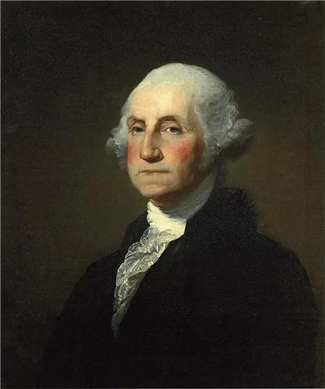
George Washington
1. Unaffiliated - George Washington - April 30, 1789 to March 4, 1797 / 1788-1789, 1792 John Adams
- Inauguration as the First President: Washington’s unanimous election as the first President of the United States in 1789 set the precedent for peaceful transitions of power and laid the groundwork for the new nation’s democratic government.
- Establishment of the Federal Government: Washington played a crucial role in setting up the framework of the federal government, including the creation of the executive branch, the judiciary, and the first cabinet.
- Ratification of the Bill of Rights: Washington supported the addition of the Bill of Rights to the U.S. Constitution, which protected individual liberties and secured greater support for the new government.
- Judiciary Act of 1789: Washington signed the Judiciary Act of 1789, which established the federal court system and ensured the independence of the judiciary.
- Financial System: Washington’s administration worked with Secretary of the Treasury Alexander Hamilton to establish a stable financial system, including the creation of a national bank and the assumption of state debts.
- Whiskey Rebellion: In 1794, Washington personally led federal troops to quell the Whiskey Rebellion, demonstrating the government’s ability to enforce federal laws and maintain order.
- Neutrality Proclamation: In 1793, Washington issued the Neutrality Proclamation, declaring the United States neutral in the conflict between Britain and France, thus avoiding entanglement in European wars.
- Jay Treaty: Washington’s administration negotiated the Jay Treaty in 1794 with Great Britain, resolving various issues and averting a potential war.
- Farewell Address: In his Farewell Address in 1796, Washington offered valuable advice on national unity, avoiding political factionalism, and preserving the new nation’s principles.
- Peaceful Transfer of Power: After two terms in office, Washington voluntarily stepped down from the presidency in 1797, setting a precedent for the peaceful transition of power and reinforcing the importance of democratic leadership.
- Establishing the New Government: Washington’s administration was responsible for setting up the new federal government under the newly ratified Constitution. This was a significant challenge as they had to define the roles and powers of the different branches of government.
- Whiskey Rebellion (1794): The Whiskey Rebellion was sparked by opposition to a federal excise tax on distilled spirits. It revealed weaknesses in the federal government’s ability to enforce its laws and highlighted the need to maintain law and order.
- Native American Relations: Washington’s administration struggled with conflicts between settlers and Native American tribes as western expansion continued. The administration’s attempts to negotiate treaties and balance the interests of settlers and indigenous peoples were often ineffective.
- Jay Treaty (1795): The Jay Treaty, negotiated with Britain, aimed to resolve post-Revolutionary War issues, but it was criticized for not addressing many American grievances, such as British impressment of American sailors and interference with trade.
- Political Factionalism: Washington’s presidency saw the emergence of political factions, primarily the Federalists and Democratic-Republicans. The divisions and disagreements between these groups complicated the administration’s efforts to govern effectively.
- Economic Challenges: The new nation faced economic difficulties, including a lack of a stable currency, heavy war debts, and the need to establish a national bank. The administration’s handling of economic matters was met with resistance and differing opinions.
- Foreign Relations: The United States navigated complex foreign relations with European powers, particularly France and Britain, who were engaged in conflicts that could potentially drag the U.S. into their disputes. Washington’s administration sought to remain neutral, but this was a delicate balance to maintain.
- Cabinet Conflicts: Washington’s cabinet members, including Secretary of State Thomas Jefferson and Secretary of the Treasury Alexander Hamilton, frequently clashed over issues such as the interpretation of the Constitution, economic policies, and the balance of federal versus state power.
- Fugitive Slave Act (1793): The administration faced criticism for the Fugitive Slave Act, which was part of the Compromise of 1793. This law required the return of escaped slaves to their owners and raised ethical and moral concerns.
- Problems with Political Patronage: Washington’s administration struggled with issues of political patronage and appointments. The concept of rewarding supporters with government positions led to accusations of favoritism and a debate about the proper role of government appointments.





